| Except for monthly Vital Conversations convened by David Nelson, CRES programs arise by request. Our management principle is "management by opportunity." Every year we are delighted by the number of opportunties given to us, as, for example, last year's list demonstrates. (Of course we also provide free private consulation to organizations and other services as requested, not listed on our public website.) |
This page is continuously updated. Events listed by date, earlist first
Transcendent meanings from COVID?
NEW YEAR UPDATE Last December 27 I discovered this and wrote: An Impromptu Report on an Unexpected Work of Public Art 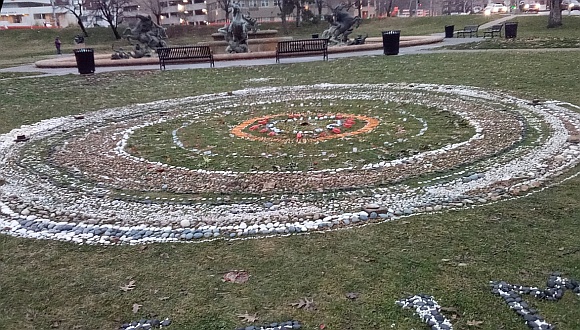 Several times a week I walk through Mill Creek Park just east of the Country Club Plaza Shopping District with its famous (I think cruel) fountain which you can see in the background of the photo above. December 27 I was surprised to encounter what, from a distance, looked like a mandala. I returned the next day to study it more carefully and was pleased it did not appear to have been molested. I remain worried that this ephemeral, complicated, thoughtful public art at the southwest end of the park will be vandalized soon. I wish I had a drone camera so I could get a better, higher view of what has obviously been constructed with great thoughtfulness and care. Careful to plant my feet not to disturb any part of the piece, I saw that a ring near the center were stones wrapped with white children's socks, and the yellow ring you can make out in the photo is made of pencils. In between are peppers. I saw other produce as well. I read the labels around the circle: 23 hospitals 100 journalists 296 schools 10305 children 473 health staff 52390 injured 1900000 displaced 26612 martyred At the outside of the circle large stones near Mill Creek Parkway read "1 stone = 1 martyred in Gaza." I do not know how accurate the statistics might be. This closer look made clear that this is not a mandala except in the original Sanskrit sense of "circle." It reminded me not Buddhist or Hindu art but rather of Picasso's Guernica which I first saw at the modern art museum in New York when I was young, before it was repatriated to Spain, where I saw it again more recently in Madrid. Reading this Mill Creek art as a pro-Hamas statement, as I suppose is possible in our reactive, political environment, is as much a misinterpretation as viewing Guernica as a pro-Socialist statement. Though not composed of cloth and pigment, the ground itself becomes its canvass with materials like stones and socks and pencils and bits of food, transporting the rubble we see in the news from there to here, and from horror to art we can just barely endure*. Like Guernica, it is a statement about the violence and horror of war, and transcends the particular occasion which originated the artistic expression. Would that such art be heeded with compassion. Hatred does not cease by hatred but by love -- such statements are found throughout the religions of the world. MORE ON 9/11 AND OTHER FOLLIES * “For beauty is nothing but the beginning of terror which we are barely able to endure . . . ." --Rilke A week later, except for the missing vegetables, this art seems unmolested: 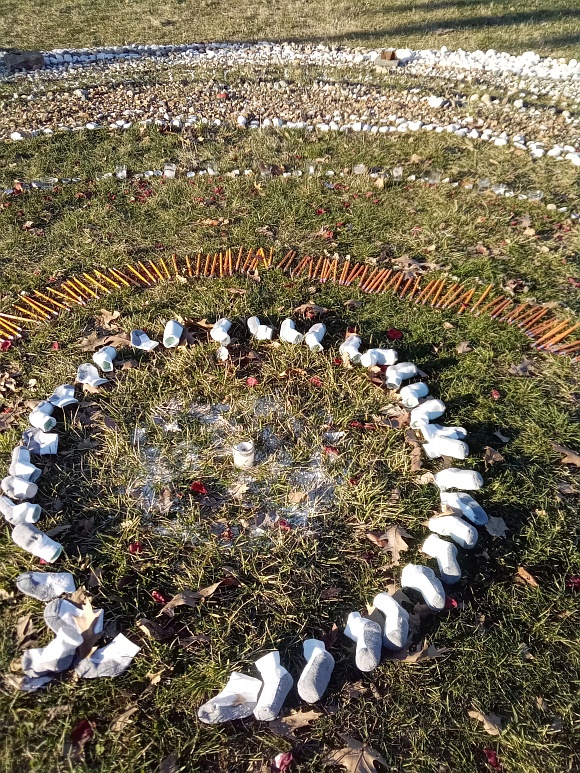 January 7: small stones on the perimeter seem to have been added with words like prayers. Long-stem rosebuds, symmetrically placed, appear half way in to the center. 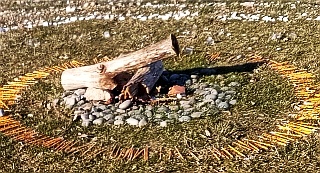 February
22: a couple pieces of fire wood have been added in the middle of the
large circle -- is this a trivial addition by someone unaware of the
symbolic meaning of the art, or does this represent the conflagration
of the Middle East? -- or some other significance which escapes me? February
22: a couple pieces of fire wood have been added in the middle of the
large circle -- is this a trivial addition by someone unaware of the
symbolic meaning of the art, or does this represent the conflagration
of the Middle East? -- or some other significance which escapes me?Feb 27 -- Except for the firewood art is still mainly unmolested for two months in the park in the entire KC region best known for demonstrations of all sorts. #240112Brooks No layman in Kansas City has done more to promote interfaith understanding and comity than Al Brooks, so we are eager to share this announcement: 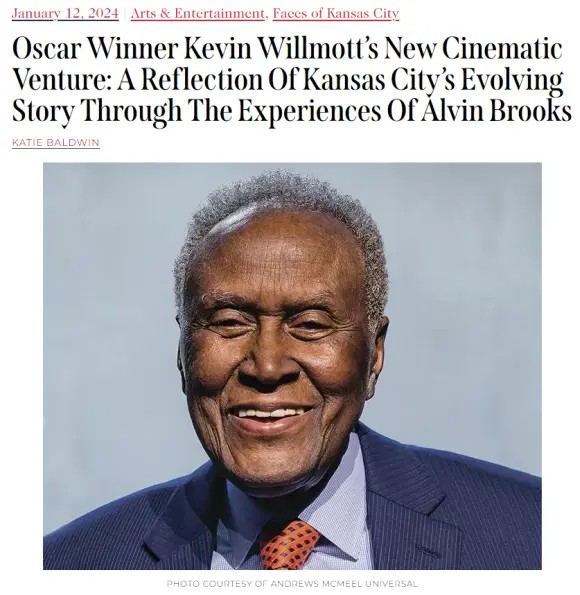 Kansas City’s cultural landscape is once again set to be illuminated on the silver screen, this time through the lens of Oscar-winning filmmaker and University of Kansas Professor Kevin Willmott. Known for his screenplay “BlacKkKlansman,” Willmott’s latest project promises to be a cinematic exploration of themes that resonate deeply within the heart of Kansas City through the life of Alvin Brooks. In a city where the tapestry of history is rich with stories of civil rights battles and cultural evolution, Willmott’s film is expected to weave a narrative that not only honors this history but also reflects the ongoing journey of Kansas City’s diverse community. This new production comes at a time when the city’s civil rights stories, exemplified by local activists like Alvin Brooks, are increasingly gaining recognition. Brooks, a civil rights icon whose memoir was released in 2021, represents the resilient spirit of KC. His decades-long fight for justice and equality echoes the sentiments that Willmott’s film aims to capture. Brooks’ story, from his time as a police officer to becoming a pivotal figure in the city’s civil rights movement, illustrates the complex layers of the city’s past, much like the narratives that Willmott has skillfully brought to life in his previous works. Willmott’s approach to storytelling, often interlaced with profound social commentary, has the potential to spark conversations and reflections on issues that are as relevant today as they were in Brooks’ era. The film is also a testament to the artistic and creative talents that thrive in KC. With a local luminary like Willmott at the helm, the production is set to showcase the city not just as a backdrop but as a character in its own right. It’s an opportunity to highlight the city’s landmarks, its unique vibe, and the stories of its people. Moreover, Willmott’s involvement in this project reaffirms Kansas City’s position as a growing hub for arts and culture. The city’s evolving narrative is being shaped by those who know it best – its artists, activists and storytellers. As Willmott brings his cinematic vision to life, he also brings with him a spotlight that shines on the richness of Kansas City’s history and its potential future. In anticipation of this film, Kansas City stands ready to see its stories told through the eyes of one of its own. Willmott’s film is not just a mirror held up to the city’s past; it’s a doorway into understanding the tapestry of experiences that make Kansas City what it is today. As audiences await its release, there’s a palpable excitement about how this film will contribute to the ongoing narrative of a city that continues to inspire and evolve. Katie Baldwin The filming is underway now. To complete the production costs of $110,000, your contribution is desired. Direct your 501(c)(3) tax-deductible gift to the Black Archives of Mid-America (Brooks Documentary), 1722 E 17th Terrace, Kansas City, MO 64108. Those who help fund the project will be listed as producers in the film. #MLK 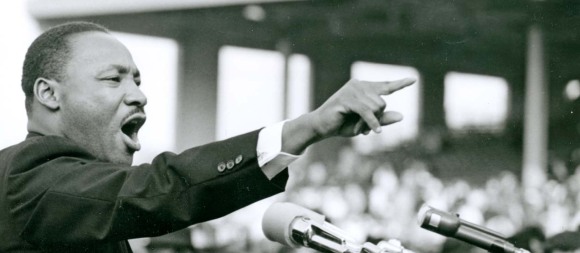 King Holiday Essay — 2023 January 16 Download a PDF of Vern's 2-page summary of the genius of the spiritual approach of Martin Luther King Jr by clicking this link. You can also read the Letter from a Birmingham Jail here. Bill Tammeus writes about King's visits to Kansas City here. Vern writes:
I remember meeting King in a church basement in
Washington, DC, the year before he was assassinated. I remember his
appearance was delayed quite a while as his team checked the church for
threats and dangers, as those of us gathered to hear him hoped to see
him alive. It was a dark time. I remember his brilliant analysis of
Vietnam, and particularly its effect on young Black men. #ThurmanInBrooks I was a student at the University of Chicago Divinity School when he was assassinated. The next Sunday was Palm Sunday, April 7, and I was to be a guest preacher. I remember struggling to find something uplifting to say, and I was thankful to be able to rely on King's teachings and his public ministry in the context of the Christian story. I used a recording of the April 3 "Mountain Top" speech in many sermons in the following months. I remember studying the writings and speeches of King, with their eloquence and depth. Each year I continue to reread the Letter from the Birmingham Jail, which every year renews me with astonishment. I also especially cherish his last sermon, March 31, at the Washington National Cathedral, a few days before his assassination. And I claim King also as an exemplar of interfaith respect, which is why I wrote this essay. In a NYTimes column, David Brooks discusses Robert Thuman's summary of the principles of non-violence. (We can add that it was in meeting Thuman that Gandhi said, “It may be through the Negroes that the unadulterated message of nonviolence [Gandhi's satyagrapha, or 'Truth-force'] will be delivered to the world.” Later King went to India himself, and kept a photo of Gandhi above his desk.) Here is a passage from Brooks which includes the summary: To be a good citizen, it is necessary to be warmhearted, but it is also necessary to master the disciplines, methods and techniques required to live well together: how to listen well, how to ask for and offer forgiveness, how not to misunderstand one another, how to converse in a way that reduces inequalities of respect. In a society with so much loneliness and distrust, we are failing at these social and moral disciplines.#PeterJarosewycz Peter Jarosewycz, 1948-2024 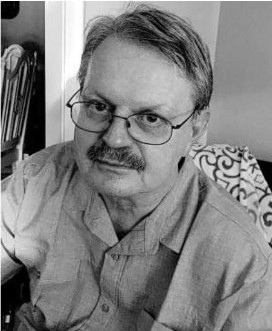 We
are greatly saddened by the death of our friend, Peter Jarosewycz.
Throughout his own physical challenges, in so many ways in our
community and beyond, he was a strong and faithful supporter of
religious pluralism, and his constant underwriting of CRES efforts over
the years must be acknowledged. He arranged many opportunities for CRES
to present programs for various groups. His clear understanding of the
profound and discriminating way CRES presents the special
treasures of the Primal, Asian, and Monotheistic faiths, and the
huge corpus of columns (947) CRES provided to The Kansas City Star,
made him one of our chief advocates. The obituary appearing in the Star
January 14, noted his extensive philanthropy, his study at the University of Chicago*,
and support of Ukrainian causes. Although his presence was not
commanding, there will be a huge gap in gatherings of interfaith
organizations this year and forward. We
are greatly saddened by the death of our friend, Peter Jarosewycz.
Throughout his own physical challenges, in so many ways in our
community and beyond, he was a strong and faithful supporter of
religious pluralism, and his constant underwriting of CRES efforts over
the years must be acknowledged. He arranged many opportunities for CRES
to present programs for various groups. His clear understanding of the
profound and discriminating way CRES presents the special
treasures of the Primal, Asian, and Monotheistic faiths, and the
huge corpus of columns (947) CRES provided to The Kansas City Star,
made him one of our chief advocates. The obituary appearing in the Star
January 14, noted his extensive philanthropy, his study at the University of Chicago*,
and support of Ukrainian causes. Although his presence was not
commanding, there will be a huge gap in gatherings of interfaith
organizations this year and forward. * " . . . about my college, the University of Chicago. They say that Chicago is a Baptist school where atheist professors teach Jewish students St. Thomas Aquinas. That’s your Interfaith America right there." -- David Brooks #240128GenevaNain  We are so proud of our former intern, Geneva Blackmer, MA, MESt, studying and working in Europe. She made many Kansas City friends and greatly enhanced the effectiveness of CRES in the community in the years she was here. She has now visited 26 countries is impressing her professors as she completes her PhD and her colleagues with her experience in electronic communications of many kinds and her work with numerous local and international interfaith organizations -- including CRES! In fact, in discussing the project announced below, she bragged about the involvement CRES had with the formation of the North American Interfaith Network -- NAIN (in 1988 Vern was a member of the planning committee for its first conference, and this in turn, lead to CRES founding of the Kansas City Interfaith Council in 1989). She currently works at the University of Bonn, Germany, in the field of Digital Religious Communication and holds a master’s degree in Religious and Ecumenical Studies. She has served as a Digital Literacy Instructor for Guiding Ohio Online, working to bridge the digital divide in rural, lower-income communities throughout that state. The discussion also addresses increasing technological hesitancy, social media awareness, and the discernment of misinformation in a digital space. Below is a presentation she makes January 28 Sunday 2 pm Central Time in the US (CET=Central European Time). 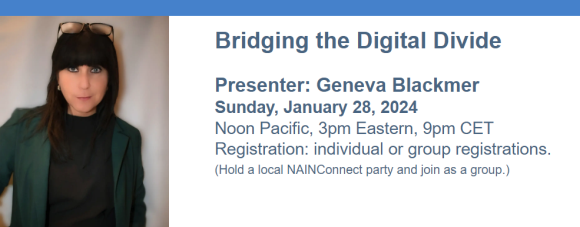 https://mailchi.mp/e512c664f9db/nain-update-03-10684142The consequences of the Digital Divide are far-reaching, affecting education, employment, healthcare, and access to government assistance. Students without reliable internet access or necessary devices face significant barriers to online learning. Job seekers with limited digital skills may struggle to compete in the modern job market, perpetuating cycles of poverty. Inadequate access to technology can limit access to essential health information and services, exacerbating health disparities. Bridging the Digital Divide requires concerted efforts to ensure technology is more equitably distributed and that individuals of all backgrounds have the tools and knowledge to fully participate in the digital age. #240128GenevaNainAfter ----------------------------------------------- 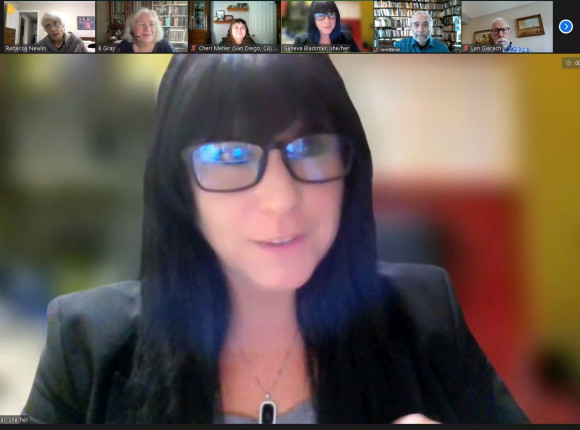 Above is a screen shot from Geneva's Zoom lecture and discussion from Bonn, Germany, for dozens of American and Canadian friends involved with interfaith work. In addition to our very own favorite, Geneva, we reconnected with Betinna Gray, who with Vern, was on the planning committee in 1988 for the continent's first conference espressly for interfaith organizations, programs, and offices. You can read The New York Times report here. Betinna also remembered CRES arranging a continental NAIN-Connect in Kansas City some years back. Using up-to-the-minute scholarship and published studies, made vivid by her own experiences, Geneva presented the surprisingly acute problem of inadequate access to critical digital information and opportunities and the alarming lack of digital content literacy, With so many occasions for religious ignorance and bias to shape our collective lives, this program made clear the harm from both mere misinformation and from pernicious disinformation. Acquainting digital users with such basic questions as the following would support more accurate information about various faiths and their adherents: * Where did you find this information? * Is this a reputable source? * Does your source of information have a particular bias? * What are the implications of posting this information? Participants exchanged responses to this problem as well as how various groups employed digital media in their own religious organizations and in thinking about interfaith activities. (CRES initiated our website in 1997 and has always managed it; so it is surprising how many faith groups are still wrestling with digital issues. We are grateful for the gifts of our friends who continue to make our digital work possible, as we are grateful for the opportunity to serve in so many ways since CRES was incorporated as a non-for-profit 501(c)3 in 1982, the oldest multi-faith civic formation, research, and educational institute in the area.)#IFHarmony February 1-7  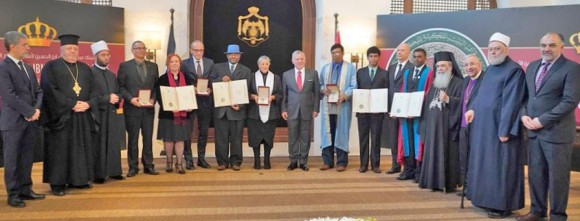 To observe World Interfaith Harmony week, we offer one of our most cited essays, "Stealing Another's Faith." The question of honoring without misappropriating material from others is not so easy, and this essay raises awareness so faiths can be less in conflict and more in harmony. Read, download this PDF, and share this important essay by Vern -- with excerpts from Huston Smith and Harvey Cox. #EIHKC update The Ecumenical and Interfaith History of Greater Kansas City 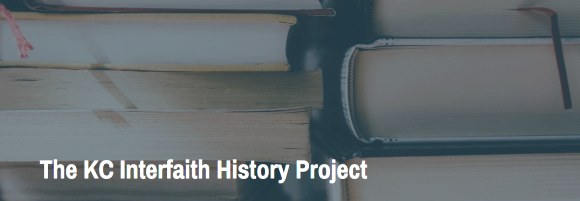 This valuable resource for understanding interfaith work in Kansas City, linked from the CRES home page (right column) and directly available here is now also available to researchers throughout the world through the ProQuest academic library database. Our former intern, Geneva Blackmer, prepared the history. The History includes both text and video. The website includes a page inviting additional contributions to further detail this critical, but often overlooked, dimension of religious and civic life in our region. #CivilReligion Discussion Notes "Civil Religion" “Civil Religion” has a bad name. Even sociologist Robert Bellah, who popularized the term in 1967, abandoned it because it has come to connote right-wing desires to fuse church and state as in the case of one proposed Constitutional amendment meant to recognize the “sovereignty of Christ.” But isn't citzenship -- beyond sectarian and partisan claims -- really a sacred gift and responsibility? --The first paragraph of Vern's essay, "Sacred Citizenship" with (now-dated?) themes of Loyalty, Freedom, and American Greatness Benjamin Franklin used the expression, "Public Religion." The term “Civil Religion” comes from Jean-Jacques Rousseau. "Civil religion, also referred to as a civic religion, is the implicit religious values of a nation, as expressed through public rituals, symbols (such as the national flag), and ceremonies on sacred days and at sacred places (such as monuments, battlefields, or national cemeteries). It is distinct from churches, although church officials and ceremonies are sometimes incorporated into the practice of civil religion. Countries described as having a civil religion include France, the former Soviet Union, and the United States." -- Wikipedia € More simply, civil religion is interpreting civil places, persons, and events within the categories of faith. Thus Donald Trump is seen by Israeli Prime Minister Benjamin Netanyahu and others as a "King Cyrus of Persia" figure delivering America (Israel) from the bondage of wicked Democratic control of the United States. Here are images over several centuries to provoke consideration of the phenomenon scholars have studied, especially since the 1967 paper by Bellah The round image and the detail below it is the oculus in the rotunda of the US Capital. The final image shown here needs no identification for Kansas Citians.  SOME US HISTORY IN BRIEF QUOTED AND PARAPHRASED Because states had different established churches, the delegates at the1787 Constitutional Convention agreed that the national government should not establish any religion, with the the First Amendment ratified in 1791 which sspecified that "Congress shall make no law respecting an establishment of religion, or prohibiting the free exercise thereof . . . " This did not, and has not, settled questions of the separation of chuch and state. * Can non-Christians be witnesses in federal courts? (settled)* Why did "In God We Trust" replace the original US motto of "E pluribus unum" in 1956? * Should we continue names of places that honor sectarian religious figures and places? -- St Louis (MO), San Francisco (CA), St Augustine (FL), the Vishnu Temple (Grand Canyon), Bethlehem (PA), Mount Zion (GA), and Mecca (CA)? * Is a fetus a person? A fertilized egg? The Roman Catholic position holds that IVF (In Vitro Fertilization) is immoral for several reasons and the Alabama State Supreme Court has found IVF is illegal because a fertilized egg is a person. Even after 1791, states continued to have established official and tax-supported churches. through gradually these practices ended. In 1833, Massachusetts became the last state to end its state religion. But not until 1844 did New Jersey's constitution protect the right of anyone of any faith to be elected to office. TWO EARLY EXAMPLES OF CIVIL RELIGION AND CHUCH-STATE SEPARATION A Letter from the President TO: The Hebrew Congregation in Newport, Rhode Island 18 August 1790 . . . The Citizens of the United States of America have a right to applaud themselves for having given to mankind examples of an enlarged and liberal policy: a policy worthy of imitation. All possess alike liberty of conscience and immunities of citizenship It is now no more that toleration is spoken of, as if it was by the indulgence of one class of people, that another enjoyed the exercise of their inherent natural rights. For happily the Government of the United States, which gives to bigotry no sanction, to persecution no assistance requires only that they who live under its protection should demean themselves as good citizens, in giving it on all occasions their effectual support. . . . May the Children of the Stock of Abraham, who dwell in this land, continue to merit and enjoy the good will of the other Inhabitants; while every one shall sit in safety under his own vine and figtree, and there shall be none to make him afraid. May the father of all mercies scatter light and not darkness in our paths, and make us all in our several vocations useful here, and in his own due time and way everlastingly happy. Geo: Washington Treaty of Tripoli "The government of the United States of America is not, in any sense, founded on the Christian Religion." --negotiated under George Washington, approved unanimously by the U.S. Senate and signed by President John Adams in 1797. ABOUT PUBIC PRAYER Please see https://cres.org/pubs/InterfaithPray.htm for discussion and examples. An opportunity to understand better who we as a community are 1. No prayer or respectful silence 2. Traditional prayers in turn (at one gathering or rotating over time) 3. Inclusive prayers using universal language ("Spirit of Generations," etc) Here is a sample of a prayer/utterance/meditation/poem seeking to be inclusive: Spirit of Community, vivid expression of our lives together in this town, we gather as atheists, Christians, Jews, Muslims, Hindus, Buddhists, and those with no particular label for our faith or no faith; and we rejoice in our pluralism, not only about religion, but in the different colors of our skin, the heritage and backgrounds that are ours, our different styles of individual and family life, and the diversity of our occupations and pursuits -- we gather that we may better understand one another as we prepare advice to send to the City Council on the priorities we wish expressed in the budget for the coming year. May we listen to one another attentively and with compassion; and, as we feel best, contribute to the conversation with the insights we offer to one another. And may we always remember and celebrate that we are part of one another as we particpate in our own ways with our sundry gifts to our Community Spirit. TWO COMMON MISCONCEPTIONS The idea that the American colonies were established for religious freedom is misleading. New England settlers were largely Puritan and wanted religious freedom for themselves, but not others. Even New York (New Netherland) had to be forced by the Dutch West India Company to allow Jews to do business there. The colonies, especially the southern colonies, were chartered as commercial enterprises, not religious havens for al faiths. But a shout-out to Rhode Island, the 1663 charter for which did include the right for anyone to practice any religion, although there were some civic and political restrictions. And Pennsylvania, which at one time was the most diverse of the colonies, also welcomed folks of all faiths, though only Christians could vote. Diana Eck, a distinguished researcher and scholar, made the claim in her day that the United States was the most religiously pluralistic country in the world. Now Great Britain has every right to challenge that, with the influx of immigrants from the former British Empire. The current (2024) Prime Minister of the United Kingdom is Rishi Sunak, for example, is a Hindu. The city of Manchester, for example, can boast of pagans, Wiccans, Satanists, Zoroastrians, Taoists, Yazidis, Shamanists, Shintoists, followers of traditional African religions, Druids, Christians, Muslims, Hindus, Buddhists, and Jews. The King has embraced religious diversity. The United States, because of its size and the diversity of its immigrants, does offer a special environment for the world's faiths as they explore the core meaning of their faiths apart from the particular cultural inflections the immigrants associate with their faith. For example, Muslims from Turkey, Iran, Pakistan, Indonesia, Saudi Arabia, Nigeria, Egypt, Black communities in America, and other places have the opportunity to discover their faith expressed in different cultural contexts, and to uncover or develop a form of Islam apart from these particular cultural backgrounds, or one that fits best in a country, such as the United States, where the government welcomes the free practice of all faiths. Muslims, to continue this example, also have the opportunity to engage with other faiths, which they may not have been able to do in their native countries. ADDITIONAL COMMENTS PRAYER.-- Whether shared silence or prayer or affirmation or poem or mission statement or other use of time is best depends on the nature of the occasion, the expectations of the group, and other such factors. For example, when invited specifically to give the prayer on a regular occasion for a legislative body, one does not simply ask the members of the body to stand in silence in their chamber, violating and insulting their expectations. The same was true in my Rotary Club where my opening phrase, "O Spirit of Generations" was picked up by other members when it was their turn to offer the opening prayer. So much depends on the occasion and expectations. For example, I learned from offering prayers to begin meetings of the KC City Council. You'll find them here: where you'll also find my reflections on my mistakes --"Where was God" in my prayer?--expectations are so important! On one occasion -- the installation of a judge, I gave a "Prologue," (item #5) as I called it; I was asked to do something that functioned like a prayer, but was not a prayer. These things are tricky, but I was apparently successful since my text was published in a legal journal. Again, I do believe one must honor expectations and the nature of the occasion. Silence would have been insulting and an opportunity to articulate an important expression of values lost. IN GENERAL, I think the problem of church-state separation is insoluble. What with chaplains for the Congress and in the military? Do soldiers have a right to exercise their religion by consulting with spiritual advisors? Are prisoners rightly deprived of their First Amendment rights to exercise their faith if they are jailed for theft? To what extent are tax dollars to pay for such services justified? I will not criticize Abraham Lincoln for obvious "civil religion" in his Second Inaugural. It spoke to the occasion in a powerful way that a merely civil text could not have done. I do not want the ceiling of the Rotunda painted over. I think the path forward is through recognition of America's diversity, including (as with a recent state execution, an atheist chaplain). One of the issues included above is "* Is a fetus a person?" I do not think we are likely to have the Alabama Supreme Court in vitro fertilization decision here without a political and judicial recognition of religious diversity, which would be a strong argument against the state's use of a single faith, Chrristianity, and just a portion of that faith, with many other Christians in profound disagreement (and those of other faiths as well) to define a fertilized human egg as a person. (Read this decision's use of the Bible and Christian theologians to justify this obvious violation of church-state limits.) My 2006 multifaith assessment of when a fertilized egg becomes a person is here. Above I listed other problems, a couple marked resolved, such as whether mail should be delivered on Sundays, and others unresolved. I do not like Christmas as a federal holiday, or Columbus day, either, which insultys American Indians. I think moving custom toward recognition of diversity is all we can hope for in the immediate future. I think the example of Judge Waxse (now of blessed memory), who was a vocal supporter of the ACLU and strongly in favor of church-state separation, charted that way forward. ADDITIONAL RESOURCES € Vern's essay, "Sacred Citizenship" available in PDF (two pages) € On-line text of "Civil Religion In America" by Robert N Bellah http://robertbellah.com/articles_5.htm originally publisjed in Dædalus, Journal of the American Academy of Arts and Sciences, in the issue entitled, Religion in America, Winter 1967, Vol. 96, No. 1, p1-21. It was reprinted with comments and a rejoinder in The Religious Situation: 1968, p331-356. € An important contribution to the discussion: "Divided We Fall: America's Two Civil Religions" by Robert Wuthnow https://moodle.swarthmore.edu/pluginfile.php/487604/course/section/169180/wuthnow.pdf Christian Century 1988 April 20, p395-399 € Two brilliant books on this topic by Forrest church: * The American Creed: A Spiritual and Patriotic Primer, 2002 * The Separation of Church and State: Writings on a Fundamental Freedom by America's Founders, 2004. € Abraham Lincoln's 1838 conception of "political religion": https://www.abrahamlincolnonline.org/lincoln/speeches/lyceum.htm € The Christian Persecution Narrative Rings Hollow https://www.nytimes.com/2024/08/25/opinion/christianity-evangelicals-persecution-faith.html € A couple sites for images https://oll.libertyfund.org/pages/images-of-liberty-andpower-presidents-day-apotheosis-of-washington https://en.wikipedia.org/wiki/The_Apotheosis_of_Washington #Shared TWO EVENTS FOR BUILDING UNDERSTANDING and RELATIONSHIPS Since 1982, CRES has promoted community and international understanding. Here are two events that demonstrate our commitment, especially in these recent extraordinarily difficult months for folks particularly attuned to the Holy Land and the increase in religious prejudice in our own nation. First:
This Sunday, February 25th at 2:00pm an event titled "CREATE SHARED HOPE THROUGH PERSONAL CONNECTION" will be held in-person at Church of the Resurrection in Leawood, KS at 13720 Roe in Building C Basement. Dr. David E Nelson, president of the Human Agenda and CRES senior associate minister, is a key figure in this opportunity for Jews, Muslims, and Christians to share hope in the context of current events through personal connection. From the event's description: "As we take in all that is happening in the world, we are tempted to retreat into our own safe tribes and families and yet our hearts long for a wider reach and a more inclusive sharing.Deep listening and strong sharing can allow us to find hope within our diverse paths and our individuals pains. As we listen to understand and share to be heard and understood, something special can happen. We together find strength to hope, ideas for action, and courage to stay human." RSVP at bit.ly/sharedhope (Advance contact information for the meeting was: Andy at campandy@me.com (913) 481-3738 or Ken at kensonnenscheinmd@gmail.com (913) 205-5962.)
#JCM Second: Offering experience and study, CRES promotes the wisdom of Primal, Asian, and Monotheistic faiths to treat the crises of the environmental, personal, and social pandemics. This was live-streamed on YouTube 2024 March 3 Sunday 2 pm CT, co-moderated by CRES former intern Geneva Blackmer in Bonn and including panelist, Kansas City's own Alan Edelman: Jewish-Christian-Muslim Dialogue: Recentering Our Common Humanity Amidst Conflict  presented The Interfaith Center at Miami University, and cosponsored by CRES, the Greater Kansas City Interfaith Council, URI North America, and the Dialogue Institute of Kansas City. PROGRAM THEME: As tensions continue to escalate around the globe in response to the war in Gaza, Antisemitic and Islamophobic incidents have reached alarmingly high rates in North America (with the Anti-Defamation League and the Council on American-Islamic Relations reporting an increase of 200-300% since October 7th). As an interfaith community, this reality calls us to reflect upon how we can remain in relationship with one another, and maintain recognition of our common humanity, even when it feels like our lives are under attack. We invite you to join us in an honest and open dialogue which considers how the Jewish, Christian, and Islamic faiths might guide us towards a path of reconciliation in our relationships with one another and the way we interact in the world. UPDATE AND COMMENT: Among the many issues raised, particularly for interfaith organizations and individuals doing interfaith work, is the unfair expection that religious groups should solve what are political problems. The conflict in Gaza is not a Jewish-Muslim problem; it is a political problem. Yet the panelists agreed that identifying and uplifting the demands of justice is a religious obligation. It would be interesting to have additional conversation about this vexing dilemma. (A possibly relevant discussion, also available on YouTube, is "Interfaith Understanding is too Slight a Thing.") Perhaps not emphasized, but implicit in the panelists comments, I think, is the failure within communities identified with each tradition to uphold the morally urgent principles of justice. This is true not only in the Holy Land but also where we may be of most immediate service, in our own local communities. The entire conversation was important, useful, and at times, inspiring. Knowing that so many of us are suffering as we seek to fully understand the unfolding horrors of the news, and finding ways to recognize that suffering in one another and one another's communities, is surely a critical step toward the time envisioned in the closing prayer, offered by Alan Edelman: A Prayer for Peace#LentenEssay For our Christian Friends: The St Paul's Episcopal Church asked me to contribute a thought about the last of the "Seven Last Words of Christ" as part of the Lenten season. 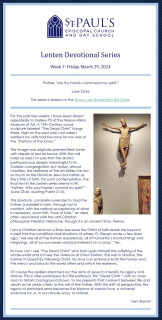 "Father, 'into thy hands I commend my spirit.'" --Luke 23:46 "Father, 'into thy hands I commend my spirit.'" --Luke 23:46This series is based on the Seven Last Words from the Cross. For the past few weeks, I have been drawn repeatedly to Gallery P5 of the Nelson-Atkins Museum of Art. A 13th Century wood sculpture labeled “The Dead Christ” hangs there, high on the east wall. Last week I realized my visits had become for me one of the “Stations of the Cross.” The image was originally painted flesh tones with streaks of red for blood. With the nail holes as well, I’m sure that the drama portrayed was deeply meaningful to its Catalan congregation; but today, almost colorless, the starkness of the art strikes me not so much as the historical Jesus but rather as the Christ of faith. For such contemplation, the final text in this Lenten series seems to fit: “Father, ‘into your hands I commit my spirit’” (Luke 23:46, quoting Psalm 31:5). This absolute, complete surrender to God the Father, is parallel in form, through not in content, with the radical acceptance of what is necessary, amor fati, “love of fate,” an idea often associated with the anti-Christian philosopher Friedrich Nietzsche, though it is an ancient Stoic theme. I am a Christian and not a Stoic because the Christ of faith leads me beyond myself into the conditions and situations of others. Fr. Steven wrote a few days ago, “we see all of the human experience, all of humanity’s shortcomings and misgivings, all of our successes and joys intersect on a cross.” Yes. So how can I see “The Dead Christ” who took upon himself the suffering of the whole world and not see the violence at Union Station, the war in Ukraine, the famine in Gaza? By following Christ, my love can embrace both the horrors and the mercy and beauty the world offers and which He redeems. Of course the soldiers stretched out the arms of Jesus to intensify his agony and shame. This is often portrayed. But this portrayal, this “Dead Christ,” with no cross and no historic background shown, to me presents that moment between life and death as he yields utterly to the will of the Father. With this shift of perspective, the agony of stretched arms becomes the blooms of cosmic love, a universal embrace for us, in our minute ways, to imitate. --Vern Barnet #240402 THE WRITE BRIDGE Winter 2023/2024 Journal Edition: "Solitude & Solidarity" Vern read his entry below 2024 April 2 Tuesday 4:30-6:30 as part of a Read-Around, recorded here beginning at about 43:45. In the Journal, it appears on page 66. Besides Vern, another alumnus from The Kansas City Star is George Gurley, who describes himself as a "professional octogenarian," another similarity the two share. His reading of his poem, "What You've Left Behind," is on page 69; and in the recording, at about 14:30. An in-person event celebrating the publication is April 27 Saturday 3:30-6:30 at the Watkins Museum, Lawrence, KS. Thanks to the Anamcara Press staff led by Maureen (Micki) Carroll, "Editor, Photographer, cat-herder." The WINTER 2023/24 Journal is available in Kansas City at Prospero's, 1800 W 39, and on line. 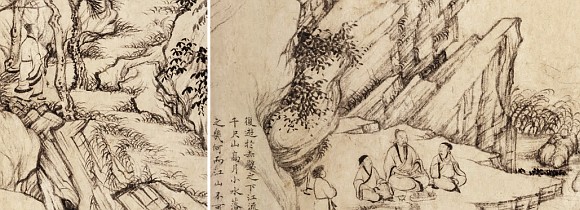 Two details from the scroll -- (1) Su Shi alone, (2) the moonlight picnic (The story moves from right to left. The entire scroll is on Wiki.) In the left detail, Su Shi, facing right, is in the upper left corner. An American Looks at Su Shi’s Night Portrayed in Qiao Zhongchang’s "Illustration to the Second Prose Poem on the Red Cliff" You left your friends to be alone, unsettled into nature’s rocks and streams, familiar trees were changed as moonlight shown into mystery and history’s regimes. The overgrowth and tangles trip your voice to shout into the cliff which echoes out a question charged, Do we have fate or choice? With crane’s sharp cry your quiet boat marks doubt. I see you dream Immortals in your home, but what is space and time and really real? How much environment, how much genome? Are choices freely made or by fate's wheel? So Han, or Gettysburg, or World Trade plots— In God’s great gambling house, are such just slots? Qiao Zhongchang was active in the early 12th Century. The handscroll (629 cm -- 248 in -- 18 feet -- length) inspiring this sonnet was itself inspired by the earlier poem by Su Shi (late 11th Century), who was jailed for his political opinions. This world-famous work is in the collection of the Nelson-Atkins Museum of Art in Kansas City, MO. Because of its age, it is rarely displayed. The Red Cliff was the site of a decisive battle in 208/9 at the end of the Han dynasty prior to the beginning of the Three Kingdoms. The story in brief: Su Shi and a couple buddies go for a midnight picnic with wine and fish. For a time Su Shi and his friends are separated. "And to climb up trees twisted like horned dragons, I pulled myself up to the precarious nests of falcons, and peered down at the hidden palace of the River God Pingh Yi. My two guests were unable to follow me this far. I suddenly let out a sharp cry. The plans and trees were startled and shook; mountains resounded, valleys echoed. Winds arose, and the water become agitated. For my part, I became hushed and melancholy, awed, and fearful. Then I began to tremble so that I could no longer remain there." As they returned by boat, a crane overhead let out a piecing cry. That night Su Shi dreamt of two Daoists who he thinks might have been the crane. Waking, he looks for the Daoists and wonders if the whole sequence was real. #Voss 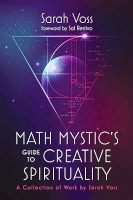 Occasionally I'm
asked to write a "blurb" about a book, and I am often happy to read and
prepare a such a comment. I actually had written about an
earlier book, What Number is God? a couple years into my weekly 1994-2012 column for The
Kansas City Star, which you can read here. Occasionally I'm
asked to write a "blurb" about a book, and I am often happy to read and
prepare a such a comment. I actually had written about an
earlier book, What Number is God? a couple years into my weekly 1994-2012 column for The
Kansas City Star, which you can read here.Now Dr Sarah Voss invited me to write about her new book, Math Mystic's Guide to Creative Spirituality, available in hard cover, paperback, and ebook. Since the other blurbs were from a physicist, psychologist, and two mathematicians, I wrote within a religious context: Do you want to know the truth? Do you want to know what is real? Both the languages of mathematical science and the revelations of faith claim to offer us truth. But with a phase/phrase change from metaphors to mathaphors and from theology to matheology, Sarah Voss, the mathematician-mystic, constructs bridges between the two languages so we can better understand--and improve--reality. --VERN BARNET, minister emeritus, #ShouseCenter for Religious Experience and Study Here's another recent "blurb"-- Deborah Shouse, who used to write the Love Story (not advice!) column for The Kansas City Star, writes on many subjects (from several volumes in the Yes, You Can financial series to Antiquing for Dummies (with Ron Zoglin) to two books about people who are living with dementia and their care partners: Love in the Land of Dementia: Finding Hope in the Caregiver's Journey and Connecting in the Land of Dementia: Creative Activities to Explore Together. In fact she and Ron have presented their dementia stories and ideas in England, New Zealand, Chile, Costa Rica, India, Italy, and Turkey. She has written hundreds of articles, essays, and short stories, and a novel, An Old Woman Walks Into a Bar. Shortly after completing the novel, Deborah's older daughter Hilee died from a drug overdose. Undertaking the process of writing to, and receiving letters from, her dead daughter, was remarkable spiritual medicine which might help many others who experience such devastating loss. Deborah asked me to write one of the blurbs for this harrowing, but ultimately life-affirming, book. This is what I wrote: 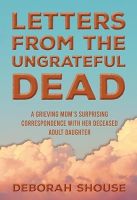 Letters From the Ungrateful Dead: A Grieving Mom's Surprising Correspondence with Her Deceased Adult Daughter, by Deborah Shouse, is a
spiritual testament to many truths. Here are three. Letters From the Ungrateful Dead: A Grieving Mom's Surprising Correspondence with Her Deceased Adult Daughter, by Deborah Shouse, is a
spiritual testament to many truths. Here are three. ° First, whether one is a believer or not, death may end a life but it does not end a relationship. Just as we can sense connection with those we love even when we are separated by many miles, so our lives remain interwoven even when death parts us by days and years. ° Second, in the words of Alfred Tennyson: "I am a part of all that I have met." We are who we are because of others, and to varied degrees can know how they think and feel. Sir Philip Sidney's sonnet, "My True Love Hath My Heart," employs the conventional poetic conceit of the exchange of hearts, but its very convention demonstrates how legitimate Shouse's exercise actually is. ° A third point: the great Iranian mystic, Yahya Suhrawardi, saw that through imagination, more than any other method, certain truths can be found. William Blake put it this way: "Imagination is Eternity." By accessing Imagination, writing to, and receiving letters from, her dead daughter, Shouse discovered in their relationship a kind of healing truth. --The Rev. Vern Barnet, DMin
minister emeritus, The World Faiths Center for Religious
Experience and Study I knew the this was too long, so I am delighted the editors were able to distill a useful point to invite readers into the book's astonishing and revelatory exercise. This link will take you to an interview about the book. Also: visit deborahshousewrites.com/ and thecreativityconnection.com/ SEVEN DAYS #SevenDays2024  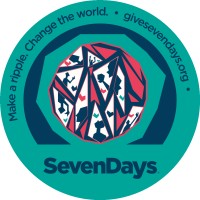 The themes help us focus on kindness in seven different ways, on seven different days. 2024 April LOVE DISCOVER OTHERS CONNECT YOU GO ONWARD The SevenDays website gives you the SevenDays story (with the horrific past on April 14, 2014), the present, and the future, the
SevenDays events this year, how to get involved, resources, and an
opportunity to shop and various sponsorship opportunities. 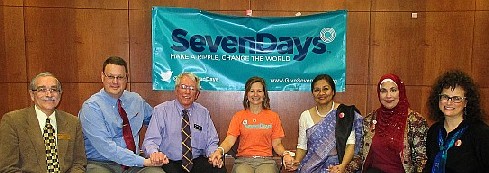 CRES
is glad to have been involved from the very first year with an
interfaith panel, and admires the folks and the organization involved
for turning tragedy into continuing community benefit by advancing
understanding and relationships. #GenevaCommentary The Future of Interfaith Work 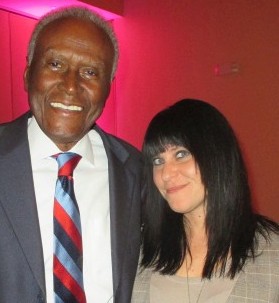 Perhaps
the most significant recent comment about interfaith work was just
published by the Interfaith Council of Metropolitan Washington, a
critique of Perhaps
the most significant recent comment about interfaith work was just
published by the Interfaith Council of Metropolitan Washington, a
critique of the many shallow and self-defeating approaches to interfaith work I've seen in my 40-some years of labor in this area. The commentary says that the over-emphasis on commonalities has undermined using the wisdom of the world's distinct traditions toward the "restoration of the environment, the dignity of the human person, and the healing of our broken community." This was written by our former intern, Geneva Blackmer, now in Germany where she is a research assistant at the University of Bonn. Because of her work with a dozen interfaith groups, we can hope her message will change things. If you'd like to see what she wrote on the agency's website, click here. Or for conveneince, you'll find it right below the logo. But first, a "save the date" note: Above we show Geneva with Al Brooks in 2016 when none of us would have guessed that we are now ready to announce that the feature about Al by Oscar-winning Kevin Willmott premieres Wednesday, June 19 (Juneteen) at Screenland, 408 Armour Rd, North Kansas City. Since I was the developmental editor for Al's memoir, I was one of many people Kevin interviewed for this film. With two showings that evening, times and other information will be announced shortly. --Vern  Here is Geneva's commentary: What is the Future of Interfaith Work? April 26, 2024 It is becoming increasingly obvious that the interfaith movement is headed towards a radical paradigm shift. As young people around the world exhibit a rapid decline in religious affiliation, important questions arise not only regarding the sustainability of the movement, but also its relevance in contemporary society. Authentic interfaith engagement is inherently advantageous and well positioned to address all the great crises of our time. It is a sacred space where we can behold the wisdom of our many beloved traditions, towards the restoration of the environment, the dignity of the human person, and the healing of our broken community. It is the place where we can arrive as our wholly authentic selves- where the complexity and intersectionality of our human identities are embraced and celebrated. And yet, contrary to common interfaith discourse, these aims prove to be largely aspirational. Despite the interfaith movement’s vision to aspire towards justice, equity, unity, and peace, interfaith spaces have become remarkably fragmented. Our collective understanding of interfaith engagement is often quite superficial- satisfied with mere religious tolerance and an overemphasis on sameness rather than difference. This emphasis on commonality inadvertently encourages conformity with Western epistemology, and the perpetuation of colonialism and Christian privilege. In this context, the use of the word “colonial” aims to describe the academic discourse surrounding “the experience, knowledge, history, and dynamics which are the result of the process of colonization” (Crist 2021). In effect, interfaith activity often inevitably serves as simply a more legitimate form of spiritual bypassing. In the face of systemic injustice, its allyship frequently equates to pleasing words and empty gestures that uphold the same oppressive structures it ideologically opposes. Often this is a consequence of our tendency to boast of religious diversity, while lacking any real racial, social, and cultural diversity. Attempts at radical inclusivity become limited when most participants are disproportionately white and demographically homogeneous. The absence of youth in religious spaces also speaks to a larger problem regarding a lack of accountability. Young people will not tolerate our inefficacy, nor will they find safety in spaces that cater to the comfortability of their most privileged members. For the interfaith movement to effectively fulfill its mission, it seems inevitable that we must work towards pragmatic accountability for our historical relationship with, and legacy of, colonialism. Are we, as an interfaith community, brave enough to admit the ways in which individuals, religious organizations, and institutions, directly or indirectly contribute to the perpetuation of inequities? My hope is that we will seize the opportunity to do better. That we will make the decisions now which set a new precedent for the future. That we can meet new voices with embrace, rather than resistance, and see to the allocation of our resources in ways which produce equity rather than uphold disparity. Perhaps then, future generations will return to a view of religion and spirituality as a means of transformation and transcendence, rather than an obstacle to progress, and we can collectively work together towards the restoration of environment, person, and community. After all, is there any option left for us? By Geneva Blackmer ReferencesInterim Director The Interfaith Center at Miami University
Vern offers his conclusions from over 50 years of experience and
study: in a troubled world, what paths lie forward? and how can one
dare offer praise for the intertwined mix of the horror and the beauty
of existence? * Doing theology is less like mathematics and more like expounding why you love someone. Film About Al Brooks Premieres
Now Kevin
Willmott, the prize-winning filmmaker (with
Spike Lee he shared an Academy Award for BlacKkKlansman),
is premiering his film about Al's life (so far!), Binding Us Together (for which I was developmental
editor), premiering locally on Juneteenth at the Screenland Armour theater. Here is an announcement (more below):
Black Archives of America presents
#Brooks_Willmott_Star --------------------------------------------------------- 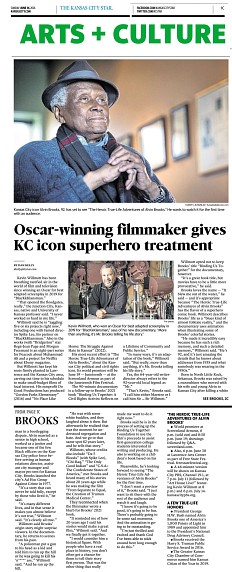 Oscar-winning filmmaker gives KC icon superhero treatment Oscar-winning filmmaker gives KC icon superhero treatment BY DAN KELLY dkelly@kcstar.com CAPTION: Kansas City icon Alvin Brooks, 92, has yet to see "The Heroic True-Life Adventures of Alvin Brooks." He wants to watch it for the first time with an audience. (Tammy Ljungblad) CAPTION: Kevin Willmott, who won an Oscar for best adapted screenplay in 2019 for "BlacKkKlansman," says of his new documentary, "More than anything, it's Mr. Brooks telling his life story." (File photo) Kevin Willmott has been breathing rarefied air in the world of film and television since winning an Oscar for best adapted screenplay in 2019 for "BlacKkKlansman." "That opened the floodgates, really," the Junction City, Kansas, native and University of Kansas professor said. "I never worked so hard in my life." Willmott said he is "juggling five or six projects right now,' including one with famed director Spike Lee, his partner on "BlacKkKlansman." Also in the works (with "Bridgerton" star Regé-Jean Page and Morgan Freeman) is an eight-part series for Peacock about Muhammad Ali and a project for Nettlix about Ebony magazine. But Willmott has kept his roots firmly planted in Lawrence and the Kansas City area, carving out time in his schedule to make small-budget films of local interest. His nonprofit Do Good Productions has produced "Gordon Parks Elementary" (2016) and "No Place Like Home: The Struggle Against Hate in Kansas" (2022). His most recent effort is "The Heroic True-Life Adventures of Alvin Brooks," about the Kansas City political and civil rights icon. Its world premiere will be June 19 — Juneteenth — at the Screenland Armour as part of the Juneteenth Film Festival. The 90-minute documentary is a follow-up to Brooks' 2021 book "Binding Us Together. A Civil Rights Activist Reflects on a Lifetime of Community and Public Service." "In many ways, it's an adaptation of the book," Willmott said. "But really, more than anything, it's Mr. Brooks telling his life story." Yes, the 64-year-old writer-director always refers to the 92-year-old local legend as "Mr." "That's Kevin," Brooks said. "I call him either Maestro or I call him Sir Sir Willmott." Willmott opted not to keep Brooks' title "Binding Us Together" for the documentary, however. "It's a great book title, but movies have to be a little more provocative," he said. Brooks loves the name — ' 'It blew me out of the water," he said — and it's appropriate because "The Heroic True-Life Adventures of Alvin Brooks" has the flavor of a superhero comic book. Willmott describes Brooks' life as a "blues kind of almost folktale reality," and the documentary uses animation when illustrating some of Brooks' colorful stories. "He made it incredibly easy because he has such a rich memory, and such a detailed memory," Willmott said. "He's 92, and it's just amazing the details that he knows about addresses from 1935 and what somebody was wearing in the 1950s." Born in North Little Rock, Arkansas, Brooks was raised by a moonshiner who moved with his wife and young Alvin to Kansas City after killing a white [page 2C ] man in a bootlegging dispute. Alvin married as a senior in high school, worked as a janitor and became one of the few Black officers on the Kansas City police force before serving as human relations director, assistant city manager and mayor pro tem for Kansas City. Brooks launched the city's Ad Hoc Group Against Crime in 1977. "It's a story that can never be told fully, except by those who lived it," he said. "It's many different lives, and in that sense it makes you almost believe it's not true," Willmott said. "It's clearly all true." Willmott said Brooks' origin story might surprise viewers. In the documentary, he returns to scenes from his past. "A policeman put a gun to his head as a kid and told him to run up the hill or he was going to kill his ass," ' Willmott said. "And he ran up the hill. "He was with some white buddies, and they laughed about it then. But afterwards he realized that was the moment he understood segregation and hate. And we go to that same spot 82 years later, and he tells that story." Willmott, whose credits also include "Da 5 Bloods" (with Spike Lee), "Chi-Raq," "The Only Good Indian" and "C.S.A.: The Confederate States Of America," met Brooks and heard many of his stories about 20 years ago while he was making the film "From Separate to Equal, the Creation of Truman Medical Center. " They reconnected when the filmmaker wrote a blurb for Brooks' 2021 book. "It reminded me of how 20 years ago I said his stories would make a great film," Wilmott said. "And we finally got it together. "I would consider him a historical figure. With people who have a real place in history, you don't often get a chance for them to tell their story first person. That was the other thing that really made me want to do it right now." Brooks said he is in the process of setting up the Binding Us Together Foundation to use the film's proceeds to assist first-generation college students interested in writing and producing. He also is working on a children's book based on his life. Meanwhile, he's looking forward to seeing "The Heroic True-Life Adventures of Alvin Brooks" for the first time. "I don't want a preview of it," Brooks said. "1 just want to sit there with the rest of the audience and watch it and laugh. "I know it's going to be good, it's going to be fun. There's probably going to be some sad moments. And the animation is going to be outstanding. "I'm just thrilled and excited and thank God I've been able to stick around here long enough to do this." 'THE HEROIC TRUE-LIFE ADVENTURES OF ALVIN BROOKS' • World premiere at Screenland Armour, 6 p.m. (sold out) and 8:30 p.m. June 19; showings followed by Q&A. screenland.com. • Also, 6 p.m. June 30 at Lawrence Arts Center as part of Free State Festival. freestatefestival.org. • A 46-minute version will be shown on Kansas City PBS, Channel 19.1, at 7 p.m. July 11 (followed by "Art House Live!" featuring Kevin Willmott at 8 p.m.) and 6 p.m. July 14. kansascitypbs.org. A FEW TRUE-LIFE HONORS • President George H.W. Bush named Alvin Brooks one of America's 1,000 Points of Light in 1989 and appointed him to the President's National Drug Advisory Council. • Brooks received the Harry S. Truman Public Service Award in 2016. • The Greater Kansas City Chamber of Commerce named him Kansas Citian of the Year in 2019. ----------------------------------------------------------------------------------------------------------------------------------------------------------------- #240620 ADDITIONAL MEDIA REPORTS ON THE FILM https://www.kmbc.com/article/kc-icon-alvin-brooks-honored-oscar-kevin-willmott/61181710 https://www.kcur.org/podcast/up-to-date/2024-06-19/a-new-documentary-gives-kansas-city-civil-serva-alvin-brooks-a-folk-hero-treatment https://www.facebook.com/TheCommunityVoice/videos/the-heroic-true-life-adventures-of-alvin-brooks-trailer/989576729046020/ 2 min trailer https://www.youtube.com/watch?v=VdmPVP19xMA Fox4 https://fox4kc.com/news/alvin-brooks-documentary-premieres-at-juneteenth-film-festival/ https://missouriindependent.com/briefs/willmotts-latest-documentary-chronicles-life-of-civil-rights-leader-alvin-brooks/ https://www.thepitchkc.com/kevin-willmotts-doc-the-heroic-true-life-adventures-of-alvin-brooks-premieres-june-19/ https://kansascitymag.com/celebrating-alvin-brooks-legacy/ https://news.ku.edu/news/article/kevin-willmotts-new-film-shines-light-on-kc-civil-rights-figure https://www2.ljworld.com/news/general-news/2024/jun/15/kevin-willmotts-latest-film-documents-life-of-civil-rights-figure-alvin-brooks/ https://www.examiner.net/new-documentary-chronicles-life-of-kansas-city-civil-rights-leader-alvin-brooks/#/ https://freestatefestival.org/event/alvin-brooks/ Video for Black History Month 2 min 31 sec https://www.youtube.com/watch?v=--KFiFJ6PoA #July4 Independence Day readings * Vern Barnet directly below * Frederick Douglass second below * A 2024 Episcopalian perspective: Fr John Spicer here
---------------
#ChristianNationalismStar "Christian Nationalism" excerpt from The Kansas City Star editorial by Yvette Walker, Aug 9, 2024 WHY SEPARATE A public opinion poll by PRRI, a nonpartisan research organization, found that 40% of people in Missouri, and 38% of people in Kansas either adhere to or sympathize with the idea of Christian nationalism, based on five statements: • The U.S. government should declare America a Christian nation. • U.S. laws should be based on Christian values. • If the U.S. moves away from our Christian foundations, we will not have a country anymore. • Being Christian is an important part of being truly Amencan. • God has called Christians to exercise dominion over all areas of American society. Not all of us agree, even among the faith community. Michael Stephens, pastor of Southwood United Church of Christ in Raytown, told me of monthly gatherings that push back against Christian nationalism, and restate the need for separation of church and state. "1 have attended marches in Liberty and Olathe. Next week I plan to attend one in Platte City, " he said. Stephens said he and a team are planning a march in Jackson County on Oct. 17, when they will walk from the Peace Pavilion in Independence to the Jackson County Courthouse. . . . . 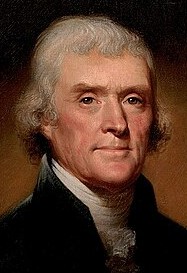 In
his 1785 book "Notes on the State of Virginia, Jefferson wrote: "The
legitimate powers of government extend to such acts only as are
injurious to others. But it does me no injury for my neighbour to say
there are twenty gods, or no god. It neither picks my pocket nor breaks
my leg." In
his 1785 book "Notes on the State of Virginia, Jefferson wrote: "The
legitimate powers of government extend to such acts only as are
injurious to others. But it does me no injury for my neighbour to say
there are twenty gods, or no god. It neither picks my pocket nor breaks
my leg." That was 239 years ago. What do people in the faith community say today? Alan Edelman, chairperson of the Greater Kansas City Interfaith Council, told me he thinks the separation not only exists, but is necessary. The GKCIC represents 24 distinct faith philosophies, including Christian, Jewish, Islam, Hindu, Baha'i, Buddhist and more. Edelman said: "Although some in our country would like to promote it as a myth, it is one of the foundations of our democracy. When we consider the number of people who have been killed in the 'name of God' throughout the centuries (and sadly today), it is clear why it is important to value and promote the separation of church and state. Thank God our Founding Fathers understood that. " #AnsweringExtremism #240821 The Interfaith Center at Miami University and CRES present: Answering Religious Extremism: Two Creative Responses to Personal Violence Speakers: Mindy Corporon and Bill Tammeus Moderators: Geneva Blackmer and Vern Barnet The program was recorded: use this link: https://www.youtube.com/live/_T-DpP2MJsY?si=RirU83sOFqbjgZwV 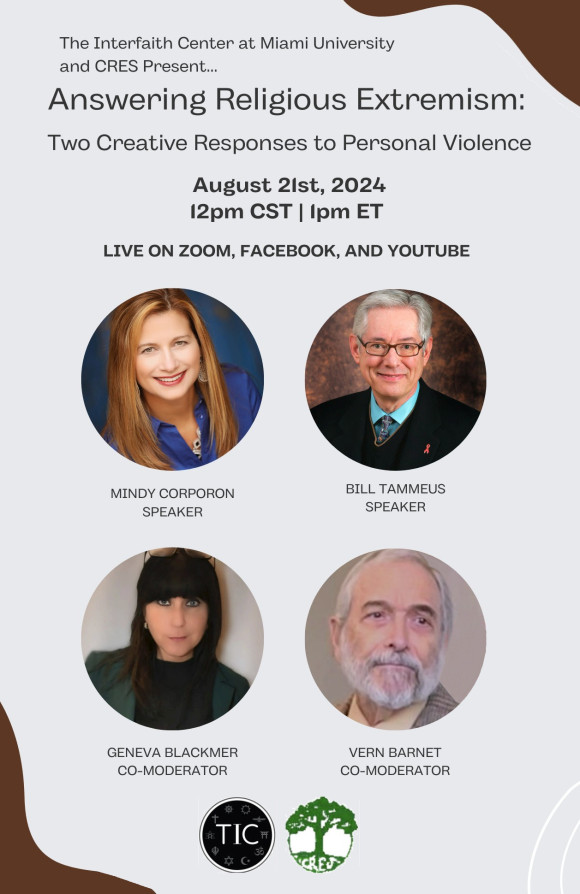 Vern's introductions: Vern's introductions:Introducing MINDY I lead an interfaith organization, proud of our work in Kansas City to uplift religious diversity, so I was shocked and remain unsettled by the murder of three Christians who happened to be on Jewish sites and were presumed to be Jews by the anti-Semite white supremisist with the weapon. How do you respond to such utter wickedness? Mindy Corporon, whose father and eldest son were two of the victims, showed the community how. An entrepreneur and former CEO of a successful wealth management firm, Mindy was reaching the pinnacle of her career when, ten years ago, this day of terror and loss changed everything. Mindy’s life purpose was transformed from guiding people financially to working for kinder communities. She founded Seven Days, Inc., to engage schools, businessess, and communities to “Make a Ripple, Change the World.” This non-profit offers opportunities for learning and dialogue for people to know and appreciate each other. Mindy also created the organization Workplace Healing and the revolutionary Human Recovery Platform™, guiding corporate leaders to strengthen their empathy muscle while preserving their organization’s cultural and financial well-being when an employee suffers from a life disruption. Mindy certainly knows about that. An inspirational speaker and the author of Healing a Shattered Soul, published in 2021, Mindy shares the story of her family’s struggle, the support of the faith community, and her commitment to courageous kindness. Introducing BILL Not long after I came to Kansas City in 1975, I asked Bill Tammeus to address my Rotary Club because I admired his writing, and particularly his understanding of faith, from reading his columns in The Kansas City Star, where he worked almost 36 years. Bill was a member of the Star staff that won the 1982 Pulitzer Prize for local reporting. His many other awards include several from the National Society of Newspaper Columnists and the American Academy of Religion, in addition to receiving the 2005 Wilbur Award given annually to the best religion column in the country. Since 2004 he has written the “Faith Matters” blog. He also writes columns for Flatland, the digital magazine of Kansas City PBS, and, until recently, for The National Catholic Reporter and The Presbyterian Outlook. His sixth book, The Value of Doubt: Why Unanswered Questions, Not Unquestioned Answers, Build Faith, was published in 2016. Bill is an elder at Second Presbyterian Church in Kansas City and a cherished teacher in many religious circles. Bill was the main speaker at the city’s central observance on the first anniversary of 9/11. His latest book, Love, Loss and Endurance: A 9/11 Story of Resilience and Hope in an Age of Anxiety, was published in 2021, arose, painfully, from the death of his nephew on that day of horror. Here are the main questions explored: We are pleased to have had 82 folks join in the program on Zoom, Facebook, and YouTube. Here are some of them. Here's the YouTube recording. Here are additional resources: * SevenDays https://sevendays.org/ * Mindy Corporon's book: https://www.mindycorporon.com/healing-a-shattered-soul/ Bill Tammeus' writings: * Amazon author page: https://www.amazon.com/author/billtammeus Upcoming Interfaith Center Events: * Sept. 5th, Confronting Prejudice: Exploring Antisemitism and Islamophobia * Sept. 11th, Compassionate Responses to Systemic Violence A few of the 82 participants: 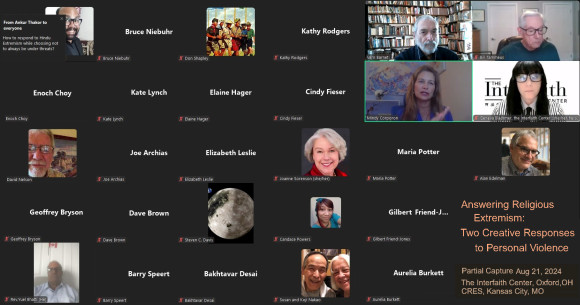 #240901 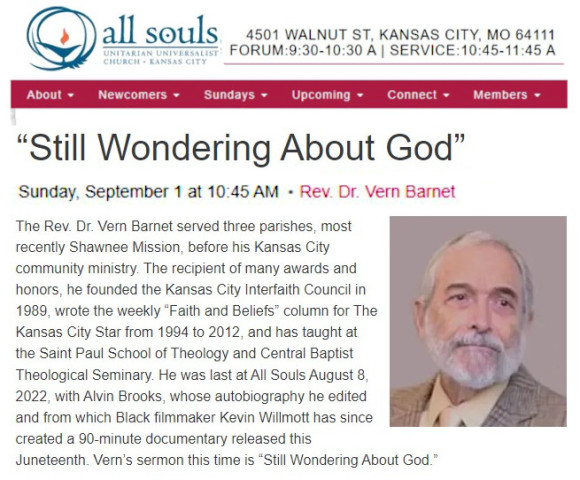 Entire Video https://youtu.be/GrGvRdAKeo0 (about 57 minutes long) Sermon begins https://youtu.be/GrGvRdAKeo0?t=1908 (about 20 minutes long)
"Nothing that is worth doing can be achieved in a lifetime; therefore, we must be saved by hope. Nothing which is true or beautiful or good makes complete sense in any immediate context of history; therefore we must be saved by faith. Nothing we do, however virtuous, can be accomplished alone; therefore we are saved by love." #anger Suggestions for Anger Management VERN: A friend asked me for thoughts about reducing a habit of the inappropriate feeling of anger. My thoughts follow: 1. Consider whether anger and maybe some anxiety arise from situations where we feel we cannot control things the way we want. 1a. Identify what triggers the anger -- and plan to be ready to breathe deeply when the trigger appears. 2. Imagine what we actually want and what is keeping us from that. 3. Anger (or other destructive emotions like anxiety) can be tamed. 4. Practice realizing that living with less anger is healtier and more enjoyable. 5. Persistent anger, anxiety, and such are destructive because they cloud clear thinking about what to do. 6. Some anxiety may arise from biological imbalences and certain medications may help. 7. Practice realizing that there was a cause for whatever caused anger, and before that, that was caused, and before that, that was caused, and so forth. People are not born to be mean but learn it from bad things that happen to them, and can unlearn the unhealthy reaction or replace it with more compassionate, wholesome emotions. 8. Collect funny cartoons from newspapers and magazines or funny TicTok or YouTube clips and review them when tired of anger or anxiety. Old humor programs -- Jack Benny, I Love Lucy, Beyond the Fringe, and others, and maybe some newer programs, give us laughs and shake anger from our body. 9. When anger flares up, give it a reasonable time limit, 2 days, or 10 hours, or 5 minutes whatever. Write down how long you've allowed the flare to last. 10. The next flare, try shortening the length of time the flare lasts. Keep an on-going journal of progress, back-sliding, and progress. Gensha, the Zen master, said, 'There is nothing left for you now but to have a good laugh." Contemplating Zen stories can be helpful. Here are two. 1. A famous soldier came to the master Hakuin and asked: "Master, tell me: is there really a heaven and a hell?" "Who are you?" asked Hakuin. "I am a soldier of the great Emperor's personal guard." "Nonsense! " said Hakuin. "What kind of emperor would have you around him? To me you look like a beggar!" At this, the soldier started to rattle his big sword in anger. "Oho!" said Hakuin. "So you have a sword! I'll wager it's much too dull to cut my head off!" At this the soldier could not hold himself back. He drew his sword and threatened the master, who said: "Now you know half the answer! You are opening the gates of hell!" The soldier drew back, sheathed his sword, and bowed. "Now you know the other half," said the master. "You have opened the gates of heaven." 2. A student came before the master Bankei and asked to be helped in getting rid of his violent temper. "Show me this temper," said Bankei."lt sounds very fascinating. "l haven't got it right now, so I can't show it to you," said the student. "Well then," said Bankei, "bring it to me when you have it." "But I can't bring it just when I happen to have it," protested the student. "I'd surely lose it again before I got it to you." "In such a case," said Bankei, "it seems to me that this temper is not part of your true nature. If it is not part of you, it must come into you from outside. I suggest that whenever it gets into you, you beat yourself with a stick until the temper can't stand it and runs away." #NCR 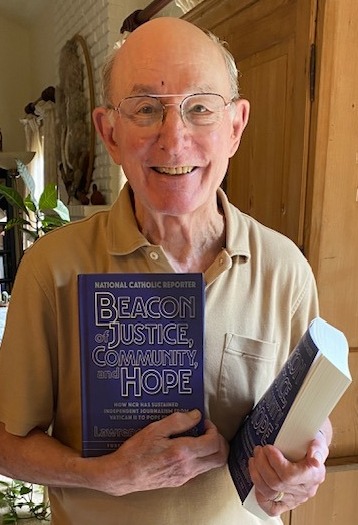 Beacon Beacon of Justice, Community, and Hope: How NCR has sustained independent journalism from Vatican II to Pope Francis Congratulations to former CRES board chair and friend of many years, Larry Guillot, on the publication of this massive (740 pages) and fascinating history of a major religious news source, significant internationally -- founded in Kansas City! A feature article in the National Catholic Reporter on Islam, around which a week of continuing education for clergy was organized, helped to set the direction of my 50-year career of interfaith work. I am not Catholic, but the NCR became an essential resource not only for keeping in touch with justice developments in the Roman Church, but also for staying current as ecumenical and interfaith explorations expanded. But I have not appreciated how precarious the publication has been, the utter dedication and struggles of its staff and management, and the wide significance of its journalism in drastically changing environments of reporting news, and in supporting it financially, until Lawrence B. Guillot, whose background both in the Church and in management, wrote this meticulously and devotedly-researched history. By reading it, I have been transformed from merely consuming NCR news to beholding the scenes behind the newsprint, and now, behind the pixels, by which those in a very human community have, through their work for others, shown their love of God and God's creation. A generous summary excerpt from the Kindle version appears on Amazon currently. The NCR announcement about the book is here. A review by Bill Tammeus appears here. --Vern ABOUT LARRY-- Lawrence Guillot is unusually well-equipped to research and write this history of the National Catholic Reporter. A former priest with a doctorate in theology, he has run nonprofits and provided expert consulting services to firms facing the kinds of issues challenging NCR. He was acquainted with NCR’s founders and has followed its evolution closely. When Pope John XXIII announced in 1959 his plans to convene the Second Vatican Council, Guillot was a master’s degree candidate in theology in Rome, living at the North American College. After ordination to the priesthood in 1960 and the degree completed, he did two years of pastoral work in his hometown of Kansas City, Missouri. His associates included NCR’s first board chair, publisher, and editor. He returned to Rome to begin doctoral work in ecumenical theology at the Gregorian University in 1963-65 and was present at the second and third sessions of Vatican II. As he had written articles for The Kansas City Star-Times and the Catholic Reporter, he obtained a press pass and attended debriefings on Vatican Council II events. When the new Joint Commission on Anglican-Roman Catholic Relations was formed, Guillot was appointed Joint Secretary, responsible for managing the Commission's working documents and reports. He completed the dissertation and published the conclusions in Ministry in Ecumenical Perspective (Gregorian University, 1969). Active in ecumenical affairs, he regularly contributed to The Journal of Ecumenical Affairs, the Ecumenist, and Unity Trends. After serving as a Catholic priest for ten years, Guillot petitioned for and received a dispensation from the clerical state and married in 1970. He and his wife Leslie, a native of Saint Louis, chose Kansas City as their home base. They have two daughters, Ann and Laura, and four grandchildren. He refocused his professional life on community service and, over the next 40 years, managed a training center for VISTA volunteers, was the first ombudsman / executive director of a human relations/civil rights office in county government, associate director of a large nonprofit community development housing agency, dean of continuing education in the metropolitan community college system, executive director of a consulting service to nonprofit social service agencies, and his own consulting service. Together with another executive director, he published Manage for Excellence: A Workbook for the Nonprofit Manager (Kansas City, 1985). From 1985 to 2011, he served as a senior graduate adjunct professor for the Graduate School of Public Affairs of Park University. He co-designed the curriculum for a new degree in managing nonprofit organizations. He taught classes in Social Policy, the Nature of the Nonprofit Sector, and the Management of Nonprofit Organizations, first in the classroom and then online. To this bio-sketch for the book, I must add a few examples of Larry's support of CRES. Larry helped arrange funding for our Gifts of Pluralism conference, wrote the evaluation of the nation's first Interfaith Academies which we hosted, arranged for Kay Barnes, then Mayor, to receive the first civic award from CRES at our annual Thanksgiving Sunday Interfaith Ritual Meal, assisted, contributed to, and helped shape The Kansas City Interfaith History Project prepared by our then-intern Geneva Blackmer, and in countless other ways has supported, and continues to support, CRES and causes of interfaith understanding. #240911 #911 A way of understanding the years since 9/11 While the 9/11 attacks opened new gates of hell, the way our government has responded has brought us inside hell's domain. The smoke from that day, the acrid fumes, amplified into war, brings us purblind to the charred and hobbled Body Politic. How do we understand what has happened? How do we move forward? And what of other international conflicts, especially the war of Russia against Ukraine? 9/11: METAPHORICAL MALADY:
1. Before 9/11, terrorism had been dealt with as a CRIME, internationally and at home. The violation of life and property in an otherwise orderly society makes the terrorist an especially despised outlaw. We employ a legal system to assure justice by punishing the criminal and removing the criminal from society. International courts have done the same. 2. But since September 11 we have used a WAR metaphor. Of course the metaphor is hardly new. We love war. We have fought the war against poverty and the war against drugs, though it is hard for us to admit defeat, even though Vietnam and Afghanistan are history now. We still fight the war against cancer, against crime, against . . . you name it. But a war against terrorism was new. The metaphor had power because we struggled not just against isolated attack but against an organized force seeking not just advantage through harm of a target but rather destruction of a government or civilization. Though we ourselves use violence, we assumed our own righteousness would bring us victory over evil. Both of the metaphors of crime and war too easily commend themselves because they are simple, and rest on the assumption that we are wholly good — and our opponents are completely evil. 3. A third metaphor might come closer to the
complexity of the situation: DISEASE.
Here the metaphor suggests not separate, competing powers but of all
humanity as a sick body, within the organs of communities, cities, and
nations, afflicted in various ways, degrading or sustaining each other
in different degrees, infected with individuals and groups poisoned (using
Buddhist language) with greed, fear, and ignorance. Now, with COVID, we
are learning that, as Martin Luther King said, “Whatever affects one directly,
affects all indirectly.” Is the disease metaphor give us any insights into the war of Russia against Ukraine?
I think this metaphor gives us an essential insight
into debilitated world governance, enfeebled by the failure to
place armaments under international control requiring some body (a
strengthened United Nations) to manage conflict between states when
states cannot resolve problems peacefully. One way of looking at this
situation, using the disease metaphor, is the war as an auto-immune
disease of the world body; Russia, which benefits from a peaceful world
order, attacks that very order, and the body must address this
illness by sending resources to return to homeostasis. Just as
chemotherapy, surgery, radiation, and other cures, can destroy healthy
cells, so the body's response to Russian aggression requires the
short-term sacrifice of some otherwise healthy parts for long-term
health. Whether the expansion of NATO will inspire a true government of
all nations is very unclear, and whether the many increasingly complex
forces of civilization lead to planetary senescence and death, or to
universal peace --
Tickets and information:.crescentpeace.org/ The Islamic Center of Johnson County Sept 27, 2024, 5:30 – 8:30 pm
and congratulates this year's speakers and honorees: Honorees: About the Shabbir Scholarship Syed Farrukh Shabbir, M.D., was a founding member of the Crescent Peace Society who passed away in 2006 after spending twenty-seven years of his life serving and supporting our community. In his memory, the Shabbir family founded the Syed Farrukh Shabbir, M.D., Memorial Scholarship through the CPS. The scholarship is awarded to a college bound graduating senior who has written the most compelling essay about the importance of peace and understanding in a pluralistic world. The 500-word essay contest is open to any graduating senior from a high school in the greater Kansas City area. The Crescent Peace Society is a Kansas City not for profit organization established in 1996. The Society was formed after the Oklahoma City bombing affected not only the victims and their families, but also our entire nation. For the Muslim community, it affected children who were afraid to attend their schools while much misinformation was spread about who committed this heinous crime.
A BRIEF HISTORY OF THE Table of Faiths EARLY YEARS -- #CouncilPhoto1989_____________________________________________________________The first Table of Faiths event, with David Nelson as convener, was a luncheon at the Marriott Muehlebach Hotel downtown Nov 10, 2005. Alvin Brooks, one of the co-chairs (Gayle Krigel, Mahnaz Shabbir, and Chuck Stanford), welcomed guests. Mayor Kay Barnes was the keynote speaker and presented the first Table of Faiths Award to Vern Barnet. The second Table of Faiths luncheon, Nov 14, 2006, honored Don and Adel Hall and Ed Chasteen. The third Table of Faiths luncheon, Nov 7, 2007, honored Alvin L Brooks and The Kansas City Star. The fourth Table of Faiths luncheon, Nov 13, 2008, included a presentation of Donna Ziegenhorn's play, The Hindu and the Cowboy. Honored were Robert Lee Hill and the Shawnee Mission Medical Center, and Steve Jeffers (1948-2008) was lovingly remembered. The fifth Table of Faiths luncheon, Nov 12, 2009, introduced The Steve Jeffers Leadership Award, given to Ahmed El-Sherif. All Souls Unitarian Church was also recognized, and Allan Abrams (1939-2009) was lovingly remembered. The sixth Table of Faiths luncheon, Nov 11, 2010, honored Notre Dame de Sion High School with the Table of Faiths Award and Queen Mother Maxie McFarlane with the Steve Jeffers Leadership Award. The seventh Table of Faiths luncheon, Nov 10, 2011 honored the Kansas City Public Library with the Table of Faiths Award and Donna Ziegenhorn with the Steve Jeffers Leadership Award. The eighth and last Table of Faiths luncheon, Nov 8, 2012, presented the theme of "Spirituality and the Environment: Caring for the Earth, Our Legacy." The Steve Jeffers Leadership Award was given to Mayor Sly James and the Table of Faiths Award went to Unity Church of Overland Park. There was no Table of Faiths event in 2013. Beginning in 2014, Table of Faiths events were no longer major downtown civic luncheons involving elected, cultural, and business leaders. With a longer evening format, the first in the new Table of Faiths dinners was held May 8, 2014, at Unity Village. --CRES ARCHIVES Vern Barnet founded the Council
in 1989 as a program of CRES and is Council Convener Emeritus. The Council newsletter has
published his brief notes about three
milestones in the early history of the Council.
#NYTimes1988
#IHP Ending KU's "Integrated Humanities Program" 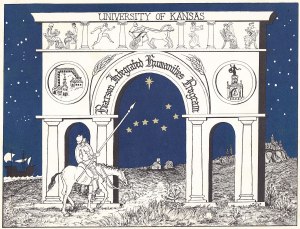 A
history student at the University of Kansas wrote to ask if he could
interview me for a report he was writing about the attractively named
"Integrated Humanities Program" at the University of Kansas that I
helped to shut down in the 1970s. A
history student at the University of Kansas wrote to ask if he could
interview me for a report he was writing about the attractively named
"Integrated Humanities Program" at the University of Kansas that I
helped to shut down in the 1970s.Two professors from the Saint Paul School of Theology (John Swomley and Carl Bangs), the executive director of the Jewish Community Relations Bureau (David Goldstein), and I formed the "Committee for Academic and Religious Liberty." We were supported by the ACLU and other organizations. We named our committee to make ut clear we supported everyone's religious freedom while opposing tax money used to advance a particular faith, and that we honored the tradition of academic freedom which protects competent professors to teach as they see fit. While I imagined the IHP was a welcome educational opportunity for many students, it also alienated select students from their families, apparently by design. The professors arrogantly dismissed such concerns. In the language of today, the professors came to use the classroom to "groom" vulnerable students for private encounters. Whether this was part of the initial plan for the program or whether it developed after the professors discovered they had created a situation which made such private encounters possible, do not know. The professors advanced the Platonic idea that education is a love relationship between teacher and student. Yes, if it's education, indoctrination. I remember talking with a student who said that he loved his professor as his father, and he no longer cared for his parents. I'm sure there were family dynamics at play, but these kids were so changed that the parents were alarmed. This is why some parents were frantic for "deprogramming," which in that time in American life, with the proliferation of "cults," books were popular about "deprogramming." With public forums, documentation, radio and newspaper coverage, and several meetings with the administrators, we encouraged KU to end the program which we believed provided the environment for religious indoctrination supported by tax money. The University discouraged the public attention we focused on the program on one hand while tacitly encouraging us on the other. The School did not want to appear to be subject to public opinion and particularly about questioning the academic freedom of the three professors. Some other professors had long been concerned about how the program isolated the students from the rest of the University and the quality of the IHP instruction. With the added pressure from the public we generated, the University finally decided the best way to rid itself of this problem and safeguard its students was to create a faculty committee to evaluate the program. With an exactitude of wording, the Advisory Committee stated that it "found no evidence that the professors of the program have engaged in such activities [as indoctrination and proselytizing] in the classroom." The complaint, of course, was that the classroom was the door inviting select students outside the classroom to religious conversion guided by the professors. The infamous trip the professors and students took to Ireland is an example of this, and the IHP trip to the Abbey of Notre Dame de Fontgombault, France, resulted in six students who took vows there instead of returning to KU with their classmates. One of these students, who had returned to Kansas more than a decade later to begin a new Benedictine monastery founded from Fontgombault, then with the name of the Annunciation Priory of Clear Creek, Oklahoma, emailed me for a purpose I could not discern. My reply was polite, with good wishes. On the monestary's website, under History and Origins, this note appears: The Integrated Humanities Program.--In the 1970s, at the University of Kansas, three professors inaugurated a Great Books program (Pearson Integrated Humanities Program, or PIHP) with a grant from the National Endowment for the Humanities. Through their study of Western Civilization, a number of these students became interested in monastic life and found their way to Notre-Dame de Fontgombault Abbey in France. Some entered the novitiate, hoping to be part of a new monastic foundation in America some day.Our Committee's favorable result led to the first interfaith award I received in Kansas City, which reads in part: The Jewish Community Relations Bureau of Greater Kansas City expresses its deep appreciation for your courageous and dedicated leadership in protecting intellectual integrity and the freedom of the human spirit by successfully challenging the Integrated Humanities Program . . . . Your accomplishment required extraordinary perseverance, infinite patience, uncommon good sense and a degree of commitment that compelled you, at great personal sacrifice, to assume responsibility for this cause. IHP shattered the lives of countless students and families. Because of you this will never happen again. . . . .Especially since I am the only survivor of the Committee's members, I was glad to visit with the student this November. In the course of our work, each Committee member prepared extensive analyses of the Interated Humanities Program. I hope some day to have the leisure to find them and related documents in the boxes of papers from my long career. --Vern #ThgvgSunday 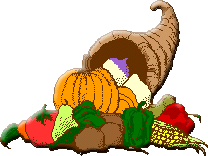 2024 November 10 Sunday Visitation Catholic Church, Tighe Hall INTERFAITH THANKSGIVING GATHERING “Promoting Interfaith Peace, Renewal and Regrowth”
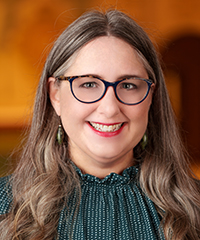 For
over 25 years Teresa's academic and personal focus has been religious
literacy, interfaith dialogue, and peacemaking. She has served on
nearly a dozen interfaith commissions, and is a vowed Lay Associate of
the Congregation of Notre Dame de Sion. Since July, 2019, she has been
the KCSJ Diocesan Ecumenical Officer and Chair of the
Ecumenical/Interreligious Commission, advancing the work of the past
ecumenical officers, now-Abbot Primate Gregory Polan and Father Paul
Turner, while incorporating her own interests and experiences. She has
a Master of Arts degree in Comparative Theology. She was at Westminster
College to work on the Central Missouri Interfaith Initiative, and
later for the Diocese of Jefferson City as a curriculum writer in the
Office of Religious Education. She applies her training and leadership
skills to facilitate unity and friendship among Catholics, non-Catholic
Christians, Jewish, Hindu, Muslims, Buddhist, and Tribal faith-filled
peoples. Read more about this year's honoree's work in Houston and elsewhere here. For
over 25 years Teresa's academic and personal focus has been religious
literacy, interfaith dialogue, and peacemaking. She has served on
nearly a dozen interfaith commissions, and is a vowed Lay Associate of
the Congregation of Notre Dame de Sion. Since July, 2019, she has been
the KCSJ Diocesan Ecumenical Officer and Chair of the
Ecumenical/Interreligious Commission, advancing the work of the past
ecumenical officers, now-Abbot Primate Gregory Polan and Father Paul
Turner, while incorporating her own interests and experiences. She has
a Master of Arts degree in Comparative Theology. She was at Westminster
College to work on the Central Missouri Interfaith Initiative, and
later for the Diocese of Jefferson City as a curriculum writer in the
Office of Religious Education. She applies her training and leadership
skills to facilitate unity and friendship among Catholics, non-Catholic
Christians, Jewish, Hindu, Muslims, Buddhist, and Tribal faith-filled
peoples. Read more about this year's honoree's work in Houston and elsewhere here.Special thanks to Kara Hawkins for her organizing and leadership skills and presence, and to Visitation Church for hosting the gathering this year. Excerpts from Teresa Albright's Remarks accepting the 2024 Vern Barnet Interfaith Service Award For the complete text, please click here. © Teresa Albright, Kansas City, MO, 2024 . . . It's important that we keep traditions like this annual interfaith thanksgiving going. . . . Interfaith spaces like this one is an opportunity to come face-to-face with people we otherwise might not encounter in our daily life. 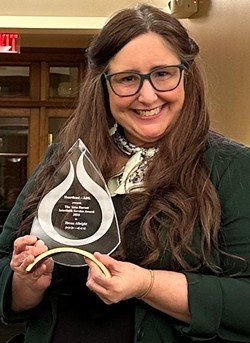 I
remember a time when I was a table moderator at an interfaith dinner
that occurred quarterly in Houston. I was one of the regular
moderators at these dinners whose job it was not only to make sure
the discussion was respectful, but that no one person coopted the
conversation. I
remember a time when I was a table moderator at an interfaith dinner
that occurred quarterly in Houston. I was one of the regular
moderators at these dinners whose job it was not only to make sure
the discussion was respectful, but that no one person coopted the
conversation.But this particular dinner, at my table, was a Yazidi man. A recent asylum seeker new to this country having fled religious persecution in northern Iraq. All other discussion about abstract notions of truth, justice and religion ceased, and we all held space for this man to share his story and tell us about his family members he had to leave behind. These interfaith spaces, our interfaith work, is important. Even if, for some of us, our own religious institutions seems hostile toward this work. Do it anyway. Especially in times when it seems the world is consumed in darkness. . . . Through this interfaith work, I have grown so much in my own faith. Occupying interfaith spaces is important, because they force us to articulate our individual religious traditions more clearly, more precisesly. We cannot assume that we are speaking the same “language of faith.” The word "salvation" in my tradition means something entirely different in another’s. Interfaith spaces allow us to practice and hone in on the heart of the matter. There are so many beautiful ideals I have come to understand better because of my participation in interfaith work. The power of non-violence as the only way to Peace. The power of Hope, especially when it is shared with others in community. The power of Beauty to elevate the ordinary. The power of Truth to shed light on injustice. And the power of Love, which will always win in the end. And I am so very thankful for all of you who are committed to interfaith work and dialogue and solidarity. As a Catholic, I cannot think of the word “thanksgiving” without thinking about the Eucharist [εὐχαριστία, "thanksgiving"], the most Blessed of our 7 Sacraments. Those Christian clergy with us today can confirm, the Eucharistic liturgy is made up of 4 ritual gestures. Take, Bless, Break, Give . . . As the days grow shorter and the night seems long and cold, may these ancient gestures sustain us and nourish us along the way. The first is to Take – Take part. Participate. Offer to help. Bring something to the table, even if all you can bring is your self. Even if no one asks you, your perspective matters, keep offering it. God can do marvelous things with the unique gifts our traditions bring to the table. The next gesture of the thanksgiving meal we call the Mass around here is to Bless. Take and Bless, Lift Up. Acknowledge. Give attention to. What does your religion lift up? What is worthy in our traditions to be lifted up? What parts of our religious culture are bearing good fruit in this age, and which parts are not? What we as religious people choose to “bless” gives it power. So let us use our words carefully. And here, I want to address clergy in particular, those of you who weild the power of the pulpit. Don’t underestimate your influence on both religious and non-religious people alike. Whether we like it or not, when clergy speaks, people listen. But letting your voice be heard comes with risk. To Bless, to lift up what is right and what is just, comes with risks. And this brings me to the third ritual gesture of thanksgiving, to Break. Moving in interfaith spaces is risky. Believe me. I know. Any kind of authentic dialogue always comes with risk. At the very least, we risk having our opinions changed. Hearing the perspectives of other people of faith may challenge you to speak up against even those in your own communities. And that is risky. And most risky of all, interfaith work may lead to looking inward, to self-examination . . . as Mr. [Alvin] Brooks often calls us to do. The final gesture is to Give, to share, to spread, to distribute. We don’t do this work for our own sake, but for the sake of the whole world. Working and moving in interfaith spaces plants seeds for a future not our own. In the words of St. Oscar Romero, one of the patron saints of this Visitation community. . . . “We plant the seeds that one day will grow. We water the seeds already planted, knowing that they hold future promise. We lay foundations that will need further development. We provide yeast that produces effects far beyond our capabilities.” This interfaith work of ours is important. It is necessary, perhaps now more than ever. . . . --------------------------------------------------------------------------------------------- An annual Interfaith Thanksgiving Sunday observance was sponsored by CRES for 25 years, 1985-2009. The KC Interfaith Council was a program of CRES, 1989-2004. We are grateful to the current sponsors for perpetuating a recognition of the place of gratitude in every faith. Pevious recipients of the award are * 2023 the Rev. Mary Gibson McCoy and the Rev. Gregory McCoy * 2019 Andy Kroesen * 2018 Barbara Criswell * 2017 Sheila Sonnenschein * 2016 Lama Chuck Sanford * 2015 Ed Chasteen, PhD * 2014 Pam Peck * 2013 The Rev Sam Mann * 2012 Barb McAtee * 2011 Dr Larry Guillot * 2010 the Rev Vern Barnet, DMn. In earlier years when the event was a Thanksgiving Sunday Interfaith Rirual Meal, CRES awards were given as follows: * 2009 Cynthia Siebert, Friends of Chamber Music * 2008 Walt and Jean Hiersteiner, civic leaders; Ahmed El-Sherif, interfaith ambassador; Even Luskin and Ward Holmquist, Lyric Opera; and William Whitener, Kansas City Ballet * 2007 Mahnaz Shabbir, Muslim leader; and the Rev David E Nelson, DMin, interfaith pioneer * 2006 Nancy and Gordon Beaham, civic leaders; and Gayle Krigel, interfaith event organizer extraordinaire * 2005 the Hon Robert T Stephan, fomer Kansas Attorney General; and George Noonan, former chancellor of the Catholic Diocese * 2004 Marc Wilson, Director and CEO of the Nelson Atkins Museum of Art; and his predecrssor, Laurence Sickman, posthumously * 2003 Congressman Dennis Moore of Kansas * 2002 Alvin L Brooks, Mayor Pro Tem, Kansas City * 2001 Art Brisbane, Publisher, The Kansas City Star; and Bill Tammeus, columnist, The Kansas City Star * 2000 Kay Barnes, Mayor, Kansas City, MO * 2009 Anand Bhattacharrya and A Rauf Mir, MD, founding members of the Kansas City Interfaith Council. The first 25 years of the annual Thanksgiving interfaith gathering was initiated by CRES, founded in 1982, and these Thanksgiving events led to the formation of the Interfaith Council in 1989. #Ahmed Introducing Islamic Heritage Imam Ahmed El-Sherif and Vern were pleased to accept invitations to discuss Islam at two Kansas City schools this fall. On Nov 10, they spoke at the St Paul's Episcopal Day School chapel time (file photo), and Dec 4 at Lincoln Preparatory Academy. At both places, they emphasized the debt the West has to Islam. The example of the smaller replica of the Giralda Seville, Spain (Kansas City's "Sister City"), on the Country Club Plaza, led Vern, tracing the historical development from the time of the Prophet (pbuh) to say, pointing to the Kansas City landmark, "Kansas City would not be Kansas City if it had not been for Muhammad." After the Reconquista expelled Muslims and Jews, Christians added a belfry to the minaret of what had been the Great Mosque of Seville. The Wikipedia article pictures both the original and the Kansas City copy. Another favorite example of the influence of Islam becomes clear with the question, "Is it easier to do math problems using Roman or Arabic numerals?"  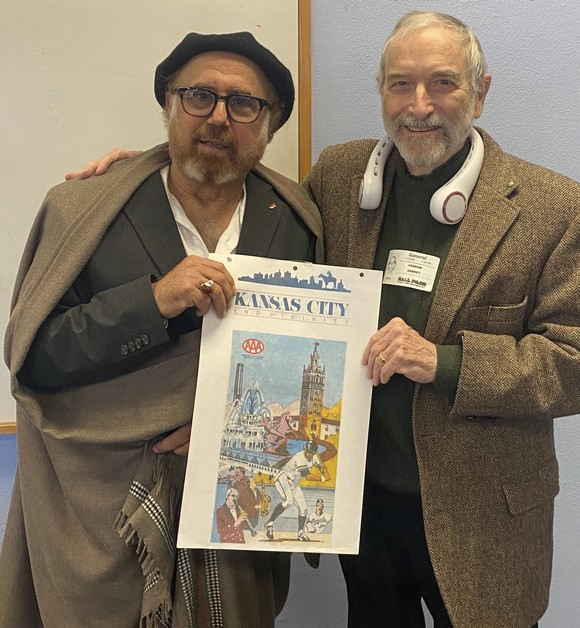 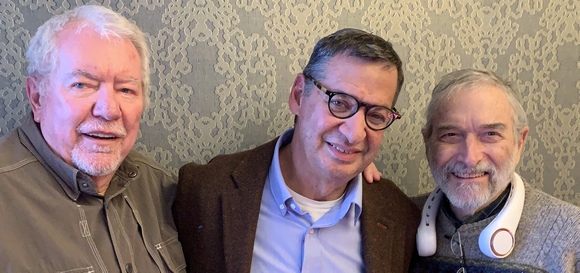 CRES
senior associate minister David Nelson and Vern express their gratitude
to Rabbi Doug Alpert (center) of Congregation Kol Ami, a Jewish
Community of Radical Inclusion, for his clear and extraordinarily
helpful remarks on various forms of "Zionism" at the informal December
luncheon of the Retired Clergy of All Faiths. Among his many
distinctions, Rabbi Alpert, a life-long Kansas Citian, is a past
president of the Rabbinical Association of Greater Kansas City. under construction
Listen to Patrick's podcast for Beethoven's birthday, December 16.  Lucy asks, "I'm looking for the answer to life, Schroeder. . . . What do you think is the answer?" Schroeder responds: "BEETHOVEN!" Vern thinks Schroeder was on to something. And here are some points Vern plans to make in the interview:
I do not recall any interest in my family in music, but we had a radio. Somehow I got hooked on broadcasts from the New York Philharmonic and the Metropolitan Opera. Somehow, in my ignorance, I sensed something important was happening, although maybe it was simply because of the applause. Because war did not make sense to me, I did not sing the National Anthem at school. When I went into the second (or third?) grade, the pincipal told me I must sing it and say the Pledge of Allegiance. I loved school; so, with anguish, I felt forced to comply. When my classmates noticed I was singing, I asked them how they liked my "opera" which then was my term for vibrato. So I had a taste for music but I was, shall we say, poorly informed. In 1951, somehow (there was no TV in my house), I saw the very first NBC Hallmark Hall of Fame program, the first opera written for TV, Amahl and the Night Visitors. I remember telling my teachers about that, and maybe it was my excitement that led the music teacher to convince my parents that I should learn an instrument, though my passion in grade school was science, and particularly astronomy. In my mature years, I was asked to teach a seminary course on religion and the arts, and I was shocked that so many graduate students had never heard of Shostakovitch and did not know what a string quartet was and had never serious encountered a Rembrandt painting or heard of Bernini's "David" or read a poem by Wallace Stevens. So recalling my childhood, I realized how lucky I was to be stimulated to persue the human spirit through the arts. But so many wre also ignorant about religion, I think because they were so embedding in their particular brand that they were unaware of the variety and sweep of human faith, and thus could not see the core of religion, the fundamental experiences out of which religion arises. I quit college in my sophomore year to study religious patterns, stories, myths, and came to see that religions and the arts historically have been inseparable. So music had something to do with significance, with patterns, and what I’d know call tacit knowledge. We know more than we can say, a key idea from Michael Polanyi. I sensed that somehow, and a question of ultimate order, or meaning, fascinated me, amd music seem to be a gateway to such knowedge. like knowing how to live your own life. In our secular society, the religious or spiritual impact of the arts may be difficult to identify and articulate because in our fragmented culture we have lost a shared language to talk about the transcendent, but if the art is effective, it opens us to meanings, relationships, perspectives, processes that partake of the sacred, which I, in short hand define this way: the sacred is what our life depends upon. However, I don't want this to sound to heavy. I remember Alan Watts, once an Episcopal priest, asking, and then answering his own question, "What is the meaning of Mozart's Jupiter Symphony? Its just an immense rejoicing." I enjoy music from Palestrina and Monteverde to John Adams, Jimmy Rogers, Steely Dan, Indian ragas and Japanese drumming and other "world music." I have my favorites like flamenco and Handel's operas. My point is Beethoven has never crowded out other music in my life, though I did spend two years almost every day listening to the Hammerklavier. Many people have the impression that the Ninth Symphony is somehow the pinnacle of Beethoven's career, the capstone, the ultimate musical testament. This may be in part because many people think of the symphonic form when they think of classical music. But most classical music is not symphonic. It is chamber music. And Beethoven's most moving and profound music is not his symphonies, as fantastic as they are (the 7th is my favorite). Particularly Beethoven's late piano sonatas and string quartets are musically and spiritually beyond the symphonies. The extraordinarily difficult Sonata 29, the "Hammerklavier," which in my opinion reaches utter sublimity in the third movement, although every movement (even the 2nd with its humor) is a miracle, and the last amazing fugal movement always offers new connections. I have over a dozen recordings of the sonata, and the elasticity of the third movement is itself amazing -- John O’Conner plays it in 14:44, and Edith Vogel's version at 23:53 is the longest. Then the last five string quartets. For me, the greatest spiritually are the A minor (#15) and the C-sharp minor (#14). In my poverty as a college freshman, I bought a second-hand turn-table without a needle, found a short piece of copper tubing, and attached a cartridge with a needle. I played those quarters in my despondency and they gave me the strength to move ahead because I knew there was a way to transmute suffering into bliss. Compared to this, the Ninth is a supreme joyous human affirmation, but the Last Quartets and Last Sonatas are divine interventions of a wholly other order. It is a little embarrassing to admit to such severe depression, but for any who might benefit from my experience before medication was even an option, I offer this report. I kept listening to the Budapest String Quartet recordings. I didn’t understand, but I kept listening I felt whoever wrote this music knew angush and despair but also pushed through them to the kind of light that Dante writes about at the conclusion of the Paradiso, a light that illumines and redeems all suffering. I did not understand, burt kept listening, and that was enough to keep me going. You would not be surprised to hear me say that as Christian Jesus is my Savior (though also as a Buddhist I mean that in a heretical way), but biographically, Beethoven is my Savior. I cannot imagine I would be around if it were not for those scratchy records. Now I know that Beethoven thought of Christ as one who suffered, and it is interesting to me to have learned that Beethovem chose always to live near chuches. Only later did I begin to appreciate how an artist’s life can shape his soul and what he produces. Finding the Heiligenstadt Testament (October 6, 1802) Beethoven's suicide note to his brothers, Carl and Johan, did I gain some insight into his despair. It runs maybe a thousand words. Here are three key passages:
OTHER ANNOUNCEMENTS
Having spawned several other organizations, including the Greater Kansas City Interfaith Council, we continue to offer programs initiated by and through others but we no longer create our own in order to focus on our unique work. For interfaith and cultural calendars maintained by other groups, click here. |
|||||||||||||||||||||||||||||||||||||||

You are welcome even if you have not read the book or seen the movie A Free Monthly Discussion Group Led by David E Nelson CRES senior associate minister president, The Human Agenda “The purpose of a Vital Conversation is not to
win an argument,
"Listen with curiosity, not judgement.” —David Nelson in dialog that will add value to the participants and to the world. In Vital Conversations, we become co-creators of a better community. —David Nelson The discussions began May 24, 2002, at the CRES facility by examining Karen Armstrong’sThe Battle for God 2024 Vital Conversations Schedule
2024 January 10 Wednesday 1-2:30 pm. David Nelson, humanagenda@gmail.com In person at the library and on Zoom ID: 832 3534 6541 ABOUT VITAL CONVERSATIONS: YOUTUBE VIDEO 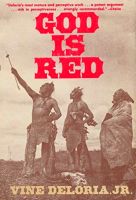 God Is Red: A Native View of Religion God Is Red: A Native View of Religion 50th anniversary and earier editions available Vine Deloria, Jr. The 50th Anniversary Edition and many copies of the original are in libraries and used book stores. This book remains the seminal work on Native American religious views. Deloria's classic work reminds us to understand that we are a part of nature, not a transcendent species with no responsibilities to the natural world. Time magazine named Vine Deloria, Jr. as one of the greatest religious thinkers of the twentieth century. 1. “I have been gradually led to believe that the old stories must be taken literally, if at all possible, that deep secrets and a deeper awareness of the complexity of our universe was experienced by our ancestors, and that something of their beliefs and experiences can be ours once again.” (xvi) Share your name and location. What do you now embrace from your ancestors that you once doubted or rejected? 2. “What we dealt with for the major portion of a decade was not American Indians, but conception of what Indians should be. While Brown’s Bury My Heart at Wounded Knee was selling nearly a thousand copies a week, the three hundred state game wardens and Tacoma city police were vandalizing the Indian fishing camp and threatening the lives of Indian women and children at Frank’s Landing on the Nisqually River. It is said that people read and write history to learn from the mistakes of the past, but this could certainly not apply to histories of the American Indian, if it applies to history at all.” (30) Why did romanticized views of historic Indians get respected even as contemporary acts of violence and plunder were common? 3.“When AIM (American Indian Movement) captured a dormitory at Augustana College in Sioux Falls, South Dakota, and presented a set of demands carefully worked out by sympathetic Lutherans in secret sessions, the Lutheran churches eagerly embraced the Indian cause…In a real sense, Christian churches bought and paid for the Indian movement and its climactic destructions of the BIA (Bureau of Indian Affairs) headquarters as surely as if they had written out specific orders to sack the BIA on a contractual basis.” (41) Why were Christian leaders eager to partner with AIM and address the evils done to Indian families and children? 4. Through nearly two decades while American Indians were rediscovering the integrity of their traditional religions, the rest of American society has torn itself and its religious traditions apart, substituting patriotism and hedonism for old values and behaviors. Give illustrations of this and discuss why this happened. 5. Developing a sense of ourselves that would properly balance history and nature and space and time is a more difficult task than we would suspect and involves a radical reevaluation of the way we look at the world around us. Do we continue to exploit the earth, or do we preserve it and preserve life? (54) Read chapter 4: THINKING IN TIME AND SPACE, and prepare to define history, nature, space, and time and discuss how different groups understand them. 6. Both religions (Christianity and Native) can be said to agree on the role and activity of a creator. Outside of that specific thing, there would appear to be little that the two views share. Tribal religions appear to be there-after confronted with the question of the interrelationship of all things. Christians see creation as the beginning event of a linear time sequence in which a divine plan is worked out, the conclusion of the sequence being an act of destruction bringing the world to an end. The beginning and end of time are of no apparent concern for many tribal religions. "The phrase 'all my relatives' is frequently invoked by Indians performing ceremonies and this phrase is used to invite all other forms of life to participate as well as to inform them that the ceremony is being done on their behalf." (76) Discuss the consequences of this different belief. (Snake dance – Morning Prayer – January 20th) 7. Indian tribes combine history and geography so that they have a 'sacred geography,' that is to say, every location within their original homeland as a multitude of stories that recount the migrations, revelations, and particular historical incidents that cumulatively produced the tribe in its current condition. (110) Share some of those stories from the book or your own history. Do you have some "sacred geography" in your life? 8. Tribal peoples, who had no difficulty with death, and saw it as part of a natural progression in the stages of life, seem to have no memory of promises of specific delights and rewards. However, they have a healthy attitude toward death that is a result of living completely within the normal earth cycles of life and death. (149) Compare that to the common Christian idea of death as reward or punishment. Read out loud Chief Seattle's speech on page 159. 9. A substantial number of people believe that becoming a Christian involves a radical change in the human being's constitution. (repent, turn around, be born again, etc.) In contrast to this attitude, the Indian tribal religions do not necessarily involve any significant change in human personality but encompass within the tribal cultural context many of the behavioral patterns spoken about by Christians (be human, kind, compassionate)." (169) What difference do you see in these contrasting ideas? 10. When we turn from Christian religious beliefs to Indian tribal beliefs, the contrast is remarkable. Religion is not conceived as a personal relationship between the deity and each individual. It is rather a covenant between a particular god and a particular community. The people of the community are the primary residue of the religion's legends, practices, and beliefs. Ceremonies of community-wide scope are the chief characteristic feature of religious activity. (178) How do you feel about this difference? Do you prefer your religion/spirituality to be personal or community based? Read Chapter 12 THE GROUP and prepare to share your opinion. 11. The status of native peoples around the globe was firmly commented by the intervention of Christianity into the political affairs of exploration and colonization. They were regarded as not having ownership of their lands, but as merely existing on them at the pleasure of the Christian God who had now given them to the nations of Europe (the doctrine of Discovery). (239-241) Discuss the doctrine of Discovery and it's current status in the world. Why have many Christian organizations taken a stand against it? 12. These crises point to Deloria's most significant contribution to humanity and the balance of life on this planet: a need to see the world—the cosmos—and our human place within it through a new lens… The non-alter-Native worldview Deloria offers essentially does the three things that are much needed. First, it suggests we return to an ancient kinship view of our relationship with the balance of life on this planet. Second, Deloria proposes that space and places should frame our understanding of history, not an abstract timeline view of history like that embodied in the US Manifest Destiny mythology. Finally, Deloria's commitment to human experience as the touchstone for what we think we know could reap tremendous rewards in this age of information and communication technology – driven nowhere spaces selling the Big Lie.” (306) Do you agree with Daniel Wildcat in his statements offered in the afterword? What other learnings are you taking from this book and our Vital Conversation about the book? 30th anniversary PDF link - - - - - - - - - - - - - - - - - - - - - - - - - - - - - - - - - - - #vcFeb2024 February 14 Wednesday 1-2:30 pm. David Nelson, humanagenda@gmail.com TIME CHANGED TO ACCOMMODATE AUTHOR: 6 pm In person at the library and on Zoom ID: 832 3534 6541 ABOUT VITAL CONVERSATIONS: YOUTUBE VIDEO 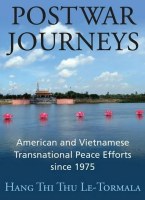 Postwar
Journeys: American and Vietnamese Transnational Peace Efforts since
1975 Postwar
Journeys: American and Vietnamese Transnational Peace Efforts since
1975 by Hang Thi Thu Le-Tormala Hang will be with us on Zoom and will share her rich insights into the relationship between these two nations and how human interaction can heal brokenness after war. “Underscoring that premise, this study explores US-Vietnam postwar relations through the transnational peace endeavors of ordinary US and Vietnamese citizens. In an attempt to understand how people transformed their negative emotions into positive actions, and how those acts helped reshape the relations between the two countries, the study choose as its subjects the lesser-known people who endured the effects of the Vietnam War.” (4) 1. INTRODUCTION “The label ‘enemy’ that they had put on one another quickly dissolved, they were but men, women, and children who endured undeletable scars of a destructive violence. The pains that they shared served as a foundation for their aspirations for peace. This book presents a picture of vibrant interactions between the two countries in the postwar years.” (6). It has been almost 50 years since The Vietnam War ended. Many citizens have learned the reality that “there are no human enemies”, we must be conditioned to engage in war. How has your thinking and conditioning changed in the past 50 years in respect to Vietnam? “Immediately after Hanoi took over Saigon and ended the war in April 1975, Washington extended the 1964 trade embargo on North Vietnam to all of Vietnam…the United States declined to recognize a reunified country renamed the Socialist Republic of Vietnam (SRV)…The War on Vietnam continued; only the weaponry had changed.” (10-11). Unlike the previous wars in the twentieth century, the United States did not see why it should help reconstruct the country that it had damaged, neither in terms of reparations nor humanitarian aid.” (15) In your opinion, why did the US continue hostile relationships with Vietnam? 2. BREAKTHROUGHS “Individuals such as Martha Winnacker were groundbreakers for the postwar transnational network of US and Vietnamese citizens who worked for peace and the betterment of people’s lives.” (17) March 16, 1977, Friendshipment had received donations from 12,852 American for the construction of a hospital on the My Lai massacre…The idea of turning a massacre site into a hospital vindicated a profound symbol of reconciliation…The My Lai hospital, founded on blood stains of a dishonorable past and built by the compassion of borderless hearts, upholds the ideal that reconciliation is always possible.” (21). Citizens, with compassion and courage, did what US as a nation was unable to do. Men and women donated and dreamed and began nurturing the healing needed. How can we promote more of these kinds of human responses? 3. BOATPEOPLE “The Los Angeles Times defined the boat people as follows: ‘They put to sea in small, overcrowded boats that are easy prey for storms, pirates, and the hostile naval forces of Vietnam and Cambodia. If they survive – and many haven’t – to reach a foreign shore, they may be interned or turned away and forced to try their luck elsewhere. These are the ‘boat people.’” (32) Tell some stories of the “boat people” and what happened to them. Explain the role National Security Advisor Brzezinski, Senator Kennedy, and President Carter all played. 4. AMERASIANS “Amerasians, children of US personnel and Vietnamese women during the Vietnam War, underwent multilayered discrimination…considered bastard because of the absence of their fathers…Culturally, xenophobia caused many Vietnamese people to be racists against descendants of interracial parents. Although Vietnam consists of more than fifty ethnicities, few interactions happened among them…’imprisoned in their own skin’”. (42) Share stories about these children and what they have encountered. What did reporter Bill Kurtis do? What about the Pearl S. Buck Foundation, Vietnam Veterans of America, and other organizations? “Despite the lack of love in their childhoods, many Amerasians nurtured the seeds of tolerance and compassion to effect change. Born in circumstances of hostility and growing up with a plethora of hatred, they deeply understood the thirst for love. Their experiences of animosity transformed them into peaceful, loving individuals. Some even used their nationless states as an advantage to advocate borderless love.” (65) 5. VIETNAM VETERANS “Most noticeable was the participation of America’s Vietnam veterans. In efforts to heal the wounds of war – for themselves and for Vietnamese people—many US veterans returned to Vietnam. Together with their former enemies, they build schools, medical clinics, and houses for the disabled. They organized cultural and academic exchanged, thus creating channels of communication that helped bring Vietnam out of isolation under the effects of the embargo” (76) “Stories of American and Vietnamese veterans working side by side to rebuild their shattered worlds remained little known…It was their shared pasts that drove the closer to one another. In their postwar struggles to adjust to their societies and to redefine themselves, these former adversaries realized they had more in common than they did with some of their compatriots” (83). In reading these stories we realize that we can now see Vietnam as a country instead of a war. Read out loud p. 93-94 “Larry Hlavaty…..felt at peace.” 6. HUMAN CONNECTIONS “At first glance, the bonds among American and Vietnamese people—the people on opposing sides of one of the most devastating conflicts in the twentieth century –may seem paradoxical and unfathomable. A closer look at the nature of their relationships, however, revealed a logical explanation. The national, and perhaps political, boundaries imposed upon these people were social constructs. Because they were social constructs, these boundaries were created and recreated over time. They were but temporary labels. The one thing that was permanent lay in their shared human emotions. Despite the military uniforms that they had put on, or the flags that they had chosen to carry, they all want peace—peace of mind and peace for their living space.” (162) Is war itself an “artificial construct” and can we nurture a global community that refuses to see war as an alternative? 7. TELL US Tell us about your current research regarding indigenous schools. How are your students being involved? How can we learn more about Native American Exhibits? ------  Clif Hostetler's complete review on Goodreads.com Clif Hostetler's complete review on Goodreads.comhttps://www.goodreads.com/review/show/6249723495 As indicated by the title and subtitle, this book is a history of postwar relations between the peoples of the two nations, United States and Vietnam. I very purposefully used the term "peoples" in the previous sentence to emphasize the nature of many of the initial actions taken to achieve peaceful reconciliation. In the early decades after 1975 many of these contacts were made in spite of embargoes and trade restrictions imposed at the national level. I pause here to reflect on the use of the term "transnational" in the book's subtitle. I wondered how the meaning of this word differs from "international." They both refer to crossing national borders, but after reading this book I believe transnational is the appropriate term to use in this case because it has a connotation of somehow floating over national boundaries as if they didn't exist. Such was the case in this history because "individuals or groups of individuals in the United States and Vietnam contested their national boundaries as well as reshaped relations between former enemies." War is a source of unpleasant memories, and one could at first think that reaching out to communicate to the other side would be painful. But the stories in this book indicate that it is those unpleasant memories of a brutal war and the consequential desire for peace that was the incentive which drove "the painstaking journeys of individuals from varied political, cultural, and social backgrounds" to put those old memories to rest. To illustrate how people transformed their negative emotions into positive actions, and how those acts helped reshape the relations between the two countries, this "study chose as its subjects the lesser-known people who endured the effects of the Vietnam War. The subcategories of these people included Vietnamese refugees, children of US personnel and Vietnamese women, US and Vietnamese veterans and their families, relatives of fallen soldiers on both sides, and other civilians who experienced the impacts of war one way or another. The study also highlights the roles of nongovernmental organizations and individuals who strove for peace and mutual understanding through transnational humanitarian and cultural activities." This book contains four chapters. The following four paragraphs are short descriptions of their content. The first chapter examines the initial turbulent years following the war. Vietnam was still listed as an "enemy country" by the US government in those years. The second chapter is about Amerasians-children of mixed US and Vietnamese parentage. Amerasians had the double disadvantage of being ostracized by Vietnamese society and generally grew up in poverty with minimal education. The third chapter describes the groundwork for normalization by ordinary citizens, with an emphasis on US veterans' contributions, from 1980 to 1994. This was the era in which USA policy inexplicably refused to label the Cambodian Pol Pot regime as "genocidal" because it would result in siding with the Vietnamese government. The fourth chapter discusses peace efforts after the establishment of diplomatic normalization. This chapter contains some emotionally touching stories about returning keepsakes to families of fallen soldiers and reconnecting family members who had been separated for many years by the war. I have a rule that I don't give five stars to a book unless I was so emotionally moved by its contents that it brought tears to my eyes—Chapter 4 did that. - - - - - - - - - - - - - - -
- - - - - - - - - - - - - - - - - - - - #vcMar 2024 March 13 Wednesday 1-2:30 pm. David Nelson, humanagenda@gmail.com In person at the library and on Zoom ID: 832 3534 6541 ABOUT VITAL CONVERSATIONS: YOUTUBE VIDEO 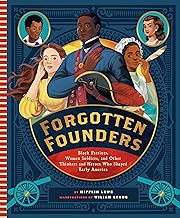 Forgotten Founders: Black Patriots, Women Soldiers, and Other Thinkers and Heros Who Shaped Early America Forgotten Founders: Black Patriots, Women Soldiers, and Other Thinkers and Heros Who Shaped Early Americaby Mifflin Lowe copies available at the library. “The purpose of a Vital Conversation is not to win an argument, but to win a friend and advance civilization.” --Vern Barnet. We continue to prepare to commemorate the 250th anniversary of the United States independence in 2026. Never in my lifetime has awareness of the Constitution and the significance of this experiment in democracy seemed so essential. We are now in the midst of a presidential campaign, and we seem so divided. The two quotations in red at the top remain my deep desire for a Vital Conversation. We each have wisdom to share, and we are all capable of listening with curiosity rather than judgment. It is my hope that these conversations can become models for each of us as we live in a political world. Rather than listing “quotes and questions” this month, I am asking you, the participants, to read and come prepared to share some of your insights and opinions. The book Forgotten Founders: Black Patriots, Women Soldiers, and Other Thinkers and Heros Who Shaped Early America by Mifflin Lowe and illustrated by William Luong, is available in most libraries. We have multiple copies at the front desk at the Antioch library which you can check out. There will be copies on Wednesday so you can come a few minutes early to read and prepare your comments. You could also pick some other resource to explore the women and men on whose shoulders we stand as citizens today. Each participant will be given time to share a story of a “forgotten founder” and then assist in a conversation about this ally. The following questions can influence your presentation, but feel free to develop your own way for sharing. ⦁ What impresses you about this person? What attracted you to his/her story? Tell the story in your own words if possible. Tell it as a story with characters, plot, situation, and resolution. ⦁ What can we learn to from this individual? Why did this person make a difference in their world? ⦁ How can we be better citizens in today’s hotly divided world? ⦁ How can we better use this time from now through 2026 to increase our personal participation in the political world? How can we lower the temperature in our interactions and increase the wisdom and enlightenment? I am requesting you to select one person from the list in the copy below and let me know by email, so we have a rich variety of people to converse about. I will send out a list several times before Wednesday with the names already selected. --David - - - - - - - - - - - - - - -
- - - - - - - - - - - - - - - - - - - 2024 April 10 Wednesday 1-2:30 pm. David Nelson, humanagenda@gmail.com 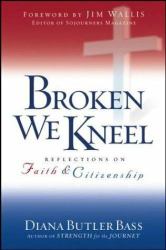 Broken We Kneel: Reflections on Faith and Citizenship by Diane Butler Bass Broken We Kneel: Reflections on Faith and Citizenship by Diane Butler BassThe relationship between Christian identity and secular citizenship has been a source of tension and conflict since the fourth century when Emperor Constantine "made Christianity the state religion of the Roman Empire."* The tragic events of September 11, 2001, renewed the ancient debate about the roles of church and state as people of faith have struggled with issues of war and peace, of terrorism and homeland security. Drawing on her personal experience as well as her knowledge of religious history, Diana Butler Bass examines the contour of the uniquely American relationship between church and state. Christian identity and patriotism, citizenship, and congregational life. This book attempts to answer the central question that many are struggling with in this age of terror: “To whom do Christians own their deepest allegiance? God or country?” *VERN'S NOTE: While Constantine did become a Christian and supported Christian causes (he convoked the Council of Nicea, 325), he continued the centuries of Roman toleration for a wide variety of religious practices. This wording above from the book cover contrasts with scholarship. For example, in Roland H Bainton's classic Christendom, vol 1, p103: "Theodosius . . . established what even Constantine had never envisaged: the Christian state." Many scholars point to the Edict of Thessalonica, 380, which seems to have decreed Nicene Christianity to be the official state religion of the Roman Empire, though local custom and variation persisted for some time. RELEASING CONVERSATION: Share your name and say something about religion and politics. QUOTATIONS AND QUESTIONS 1. “President Lincoln knew terrorism and war; he knew about good and evil. Yet at this painful moment in American history, he chose not to invoke God on behalf of victory for his cause. Rather, President Lincoln mused upon the complexities of faith and nationhood for both the Union and confederacy: Both read the same Bible, and pray to the same God; and each invokes His aid against the other . . . . The prayers of both could not be answered; that of neither has been answered fully. The Almighty has His own purposes. . . . With malice toward none; with charity for all; with firmness in the right, as God gives us to see the right, let us strive on to finish the work we are in; to bind up the nation’s wounds . . . to do all which may achieve and cherish a just, and lasting peace, among ourselves, and with all nations.” (6) What can these words continue to bring to our understanding of the role of politics and religion? 2. “Historian Martin Marty once grouped the two major traditions into the large categories of ‘priestly’ and ‘prophetic’ civic piety. Priestly civil religion tends to bless the established order that fuses a ‘historic faith’ with ‘national sentiments.’ Prophetic civil religion, on the other hand holds the nation accountable to God’s standards and judgement.” (8). Discuss how that distinction clarifies the political rhetoric in this year’s presidential campaign. 3. “To represent who we have become, civic faith needs to be deeply ecumenical and represent the faiths of the whole world.” (9) “I think Americans deserve the democratic process, as well as the spiritual practice, of forging a new sacred canopy of meaning together in community.” (10-11) Do you agree? What would that mean as you converse about politics and religion? VERN'S NOTE: A quibble.-- The word "ecumenical" properly used means the "household," the 'whole world" of Christianity, including Lutherans and Catholics, for example; "interfaith" is best used when referring to two or more different religions, such as in a "Christian-Muslim" dialogue. Other important related words are "multifath" and "intra-faith." 4. “The citizens of God’s city may be found in every earthly city. They are scattered among the nations. Their unity in Christ transcends the divisions of ethnicity, class, and nationhood and constitutes a new people who embody God’s reconciling peace. According to biblical witness, Christian citizenship is fundamentally at odds with violence on behalf of the state’s political, economic, and geographical division of humanity.” (28) What would it mean if we really believed that and lived it in our everyday thinking and living? 5. “Redemption is not a matter of human will, moral purity, or military might; redemption is the free gift of a suffering and bleeding God. In the Christian story everyone—and every nation—stands in need of God’s redemption. And the Bible itself teaches that no one, apart from God’s action, is holy.” (54). How can we authentically be both American citizens and baptized Christians? Discuss living our faith in our nation and in other nations. 6. “God changes us through the compassionate hospitality of love. Church is an encounter with a reality only distantly perceived in other parts of life, the place where the veil between earth and heaven is rent, and where through each other, we can finally touch God. Chapel is about controlling the disorder, about making religion easy. Church is never easy the way chapel can be. Church is about the kind of comfort that makes God’s people fearless comforters. Chapel is about what is. Church is about entering into divine chaos, trembling with fear and vulnerability, and finding—at the edges of the universe—God’s suffering, reconciling love.” (82) Say that in your own words and talk about what that means in your congregation or religious organization. What is the difference between being CHURCH and being CHAPEL? VERN'S NOTE: This may be misleading. Both church and chapel are Christian places for worship and other activities. (Some chapels may be designated "interfaith.") Generally a church usually has a regular congregation served by permanent clergy such as priest or minister. A chapel is often a part of a larger institution, such as a hospital, military base, or university, or palace, and may or may not have permanent clergy attached; if so, positions may be named dean or chaplain. Chapels may serve restricted groups, such as royal families, sailors, school bodies; and they may have specialized functions, such as memorials or for weddings. It is not unusual for a church to have one or more chapels within it for use for services that are attended by a portion of the congregation. 7. “From the very beginning, the majority of Jesus followers understood themselves to be citizens of God’s city, who repudiated the ‘militaristic nationalism’ of the surrounding culture.” (86) Why do you think that changed? Is it possible to reembrace that earlier understanding of what it meant to be Jesus’s followers? 8. “Christian empire is an oxymoron, fundamentally an earthly impossibility, despite what may seem to be manifestations of it. . . . As Richard Horsley points out, “Many Americans cannot avoid the awkward feeling that they are now more analogous to imperial Rome than they are to the ancient Middle Eastern people who celebrated their origins in God’s liberation . . . who lived in covenantal principles of justice.” (96) How do you sort out your faith and your place in America in 2024? Discuss the distinction God’s Liberation vs. Christian empire. 9. “The cross is our patris; God’s peace is our security. The goal of God’s people is shalom, dedication to a way of life that embodies peace – not security. Ours is a spirituality of exile, of quest for a homeland that remains elusive, and of trust that God’s love is our only true security.” (109) Discuss this vision that for so many seems beyond our current possibility. Should our “reach exceed our grasp” as visionaries have suggested or must we settle for less in our world? - - - - - - - - - - - - - - - - - - - - - - - -
- - - - - - - - - - - - - - - - - - - -
#vcMay
“The way to heal these great divides
in one person at a time.” David Brooks, the celebrated pundit, 62, has
turned his gaze to America’s Divisions. “I think as a society we are
over-politicized and under-moralized. We spend too much tie thinking
about politics and not enough time on the things that really matter,
which are having courage and honesty, being honorable and being capable
of great love. I
have learned something profound along the way. Being openhearted is a
prerequisite for being a full, kind, and wise human being. But it is
not enough. People need social skills. The real process of, say,
building friendship or creating a community involves performing a
series of small, concrete actions well: • Being curious about other people; Releasing Conversation: Share your name and your star and arrow. “Features of the Illuminator’s gaze: “Every man bears within him the germs of every human quality, and now manifests one, now another, and frequently he is quite unlike himself, while still remaining the same man.” (36) “Morality is mostlyabout how you pay attention to others. Moral behavior happens continuously throughout the day, even during the seemingly uneventful and everyday moments.” (38). As you continue to mature and grow in integrity describe how David Brooks reflections are helpful to you. Share illustrations from your own life. Read page 64 out loud.
“Constructionism is the recognition, backed up by the last half century
of brain research, that people don’t passively take in reality. Each
person actively constructs their own perception of reality.” (64) Discuss what this reality means to you and those your know and love. 1. Treat attention as an on/off switch, not a dimmer. SLANT method: sit up, lean forward, ask questions, nod your head, track the speaker. Listen with your eyes. That’s paying attention 100 percent.
“There’s
a certain spot on this earth that is somehow sacred, the place where
you come from, the place your never quite leave.” (230) What is that place for you? It may be your hometown or a space you often visited, as a child and adult. “What
is culture? It’s a shared symbolic landscape that we use to construct
our reality. People who grow up in a different culture see the world
differently – sometimes on the most elemental level.” (237) “But people
are not passive vessels into which culture is poured; each person is a
cultural con-creator, embracing some bits of their culture, rejecting
others – taking the stories of the past and transforming them with
their own lives. To see a person well, you have to see them as culture
inheritors and as culture creators.” (236). Describe cultures you have inherited, cultures you have encountered and cultures you have created. --- - - - - - - - - - - - - - - - - - - - - - - - - - - - - - - - - - - - - - - - - - - - - #vcJun The Education of Corporal John Musgrave: Vietnam and Its Aftermath by John Musgrave.
Friends: Below is a brief statement about "Patriotism - Needed in 2024." I am inviting all of us to engage in the conversation as we prepare to commemorate our 250th birthday in 2026, which I wrote to invite you to ponder what patriotism means to you and to share in a Vital Conversation in June.
Patriotism — noun, the quality of being patriotic; devotion to and vigorous support for one's country.
- - - - - - - - - - - - - - - - - - - - - - - - - - - - - - - - - - - - - - - - - - - - #vcJul "Restorative Justice: We Need a New Paradigm"
Kendall
Hughes, a colleague and friend who has embraced "restorative justice"
in his work and life joins us. Kendall was my supervisor in the
"Life Connections Program" at the US Penitentiary in Leavenworth.
He is the founder and leader of "Three Rivers Restorative Justice" in
Minnesota. You can prepare by reading Until We Reckon: Violence, Mass Incarceration, and a Need to Repair
by Danielle Sered. You can also read my statement below and look
for stories to share from newspapers, your reading, and life
experiences.
 Clif Hostetler's complete review on Goodreads.com Clif Hostetler's complete review on Goodreads.comhttps://www.goodreads.com/review/show/6608387756 The United States has one of the highest per-capita criminal incarceration rates in the world, yet the prevalence of violence is relatively high. It's apparent the high incarceration rates are not achieving the desired results. This book presents the tools and techniques of restorative justice as a proposed alternative to the use of incarceration by the criminal justice system. Restorative justice is a philosophy that aims to repair harm caused by criminal behavior by focusing on the actual needs of victims, offenders, and the community. TWO VIDEOS about Restorative Justice A 4-minute animation: https://www.youtube.com/watch?v=KLPZy2wW-x8 A 29-minute edit from a Restorative
Conference with 14 people in a school setting about a fight as well as racial and sexual orientation slurs. Kansas City CENTER FOR CONFLICT RESOLUTION: https://www.ccrkc.org/ - - - - - - - - - - - - - - - - - - - - - - - - - - - - - - - - - - - - - - - - - - - - #vcAug - - - - - - - - - - - - - - - - - - - - - -
- - - - - - - - - - - - - - - - - - - - #vcSep Democracy Awakening: by Heather Cox Richardson, At
a time when the very foundations of American democracy seem under
threat, the lessons of the past offer a road map for navigating a
moment of political crisis. In Democracy Awakening, acclaimed
historian Heather Cox Richardson delves into the tumultuous journey of
American democracy, tracing the roots of Donald Trump’s “authoritarian
experiment” to the earliest days of the republic. She examines the
historical forces that have led to the current political climate,
showing how modern conservatism has preyed upon a disaffected
population, weaponizing language and promoting false history to
consolidate power.
 Clif Hostetler's complete review on Goodreads.com https://www.goodreads.com/review/show/6812312420 For embedded links, vist the Goodreads web page above.
- - - - - - - - - - - - - - - - - - - - - - -
- - - - - - - - - - - - - - - - - - - - #vcOct
#vcNov The Sentence A
small independent bookstore in Minneapolis is haunted from November
2019 to November 2020 by the store's most annoying customer. Flora dies
on All Souls' Day, but she simply won't leave the store. Tookie, who
has landed a job selling books after years of incarceration that she
survived by reading with murderous attention, must solve the mystery of
this haunting while at the same time trying to understand all that
occurs in Minneapolis during a year of grief, astonishment, isolation,
and furious reckoning.
 Clif Hostetler's complete review on Goodreads.com
- - - - - - - - - - - - - - - - - - - - - - - - - - - - - - - - - - - - - - - - - - - - vc#Dec A Fever in the Heartland: The Ku Klux Klan’s Plot to Take Over America, and the Woman Who Stopped Them The Roaring Twenties – the Jazz Age—have been characterized as a time of Gatsby Podcast: https://thesacredpodcast.podigee.io/ Ten Questions for a Vital Conversation about the KKK IN THE 1920S
1. What were some of the key factors that contributed to
the rise of the Ku Klux Klan's influence during the early 1920s?
Share stories you have heard about KKK activity. - - - - - - - - - - - - - - - - - - - - - - - -
- - - - - - - - - - - - - - - - - - - - Vital Conversations Vital – that which creates life and hope. Conversations – intentional moments of listening and talking From David Nelson: I am shifting the focus of Vital Conversations from being a “book club” to becoming more a “discussion group”. There will be a word, or name that is the focus of the conversation. I will likely still mention a book, movie, event, newspaper or magazine article, podcast, or even TV show that I think adds to the understanding. I invite you, the participants, to research and bring other stories, opinions, and material for our Vital Conversation. For example: December 11th KKK is the topic. I will mention a book I am finding provocative. I trust you will also explore books, movies, etc. that will enhance our conversation. I will also invite individuals who have a connection in some way to the theme. I request that you invite people who can add something to the conversation as well. The point I am making is that YOU are also empowered to assist in creating a “Vital Conversation.” Vital Conversations are an idea. People have less fear when they understand others. Having intentional conversations with people we disagree with or do not understand adds value to everyone. Vital Conversations are gatherings where we become creators of a more hopeful community. Vital Conversations are intended to deepen personal meanings, foster respect between diverse individuals, enable individuals to appreciate themselves and others, and grow spiritually. Vital Conversations are not intended to be meetings where agreements, compromise or consensus is achieved. It is often the case that new levels of understanding occur, but the purpose is not to reach agreement. Although I sometimes make changes in the schedule here is my current plan for the next few months. I hope you can embrace this idea and join others who are attracted to vital conversations and creating a better world. January 8, 2025, PILGRIMAGE February 12, 2025, GENDER AND PRONOUNS March 12, 2025, TYRANNY April 9, 2025, BONHOEFFER May 14, 2025, PTSD, TRAMA I always welcome feedback and suggestions for making Vital Conversations better. This is a journey I have enjoyed for over a decade and hope to continue, with your support, for several more years. - - - - - - - - - - - - - - - - - - - - - - - -
- - - - - - - - - - - - - - - - - - - - YOUTUBE VIDEO ABOUT VITAL CONVERSATIONS "Why
would a 63 old woman walk 522 miles across the northern coast of Spain?
What did she hope to accomplish? Where did this idea come from? What
did she discover about herself? What did she discover about others on
the path? What didnature and the universe have to tell her, show her,
share with her? Why does her life feel different? - - - - - - - - - - - - - - - - - - - - - - - - - - - - - - - - - - - - - - - - - - - - Selections are subject to change. For Zoom
link and additional information,
|